ALLIGATOR
BEHAVIOR page 2h: SOCIAL SIGNALS AND BELLOWING 8 1 2 3 4 5 6 7 9 10
This
page was born 06/14/2013. Rickubis designed it.
(such as it
is.) Last update: 03/25/2021
Images
and contents on this page copyright © 2001 - 2021 Richard M.
Dashnau
Alligators,
although they are ectothermic and also equipped with a small
brain,
exhibit
a surprising diversity in their responses to their environment
and to
each
other.
They are for more complex than mere animated logs or
12-foot-long
eating machines. This group of pages show some of what I've been
able
to
see in the years I've been
volunteering (September of 2001 through March of 2020) at Brazos
Bend
State
Park.
10/06/2019
On
the Spillway Trail at BBSP, I noticed an alligator moving slowly
in
the water in the same direction I was walking. I always look at
alligator,
but this one got extra attention. That was because it was
swimming with
it head tilted back slightly, which lifted its lower jaw out of
the
water.
From experience, I figured that this alligator was "up to
something" more than foraging for food or cruising. The head
lift
(picture lower left) is one of
a series of "agonistic" displays
performed by alligators. "Agonistic" refers to aggressive
interactions--but this includes behaviors that are meant to
avoid
aggression,
or to minimize it. Alligators normally cruise or forage in water
with
their head flat--lips below the surface, tip of the nose just
above the
surface.
It wasn't long before the alligator did another social
display--a head-slap. The remaining three images are frame
grabs
form the short video clip . The
video
clip
also has notes describing the performance of a head-slap. The
images
are from images taken from a video, and cropped. The camera also
has a
powerful
zoom. I was at least 20 yards away from this alligator,
so the head-slap was most likely not directed at me. Aside
from
direct observation of them for about
17 years; my sources for
information on alligator social signals comes from 3 main
sources:
"Social Signals of Adult American Alligators" ,by Garrick
and
Lang
(1978);
"Social Displays of the American Alligator", Kent
Vliet
and, Biology
and Evolution of Crocodylians by Grigg and Kirshner.
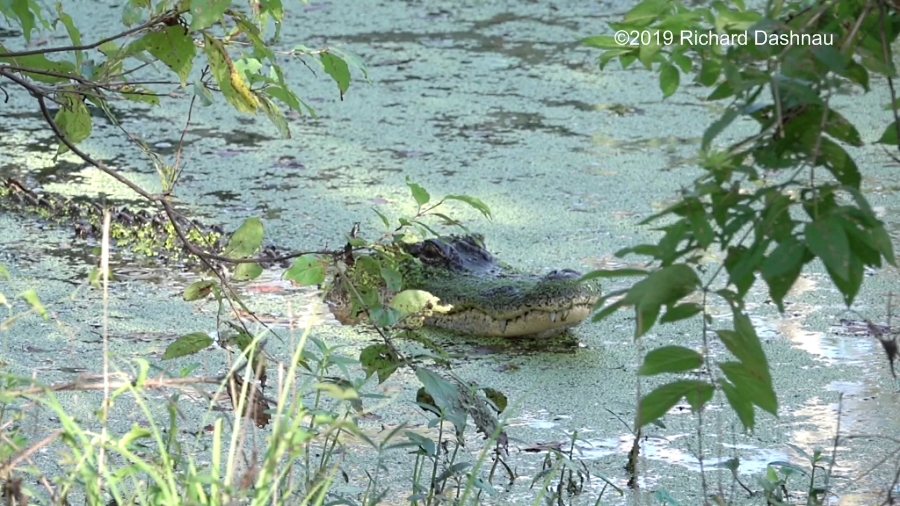
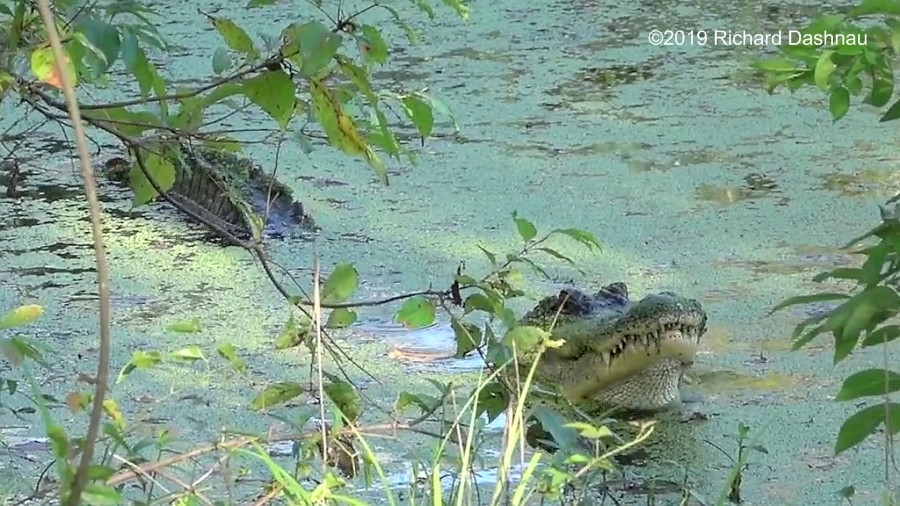
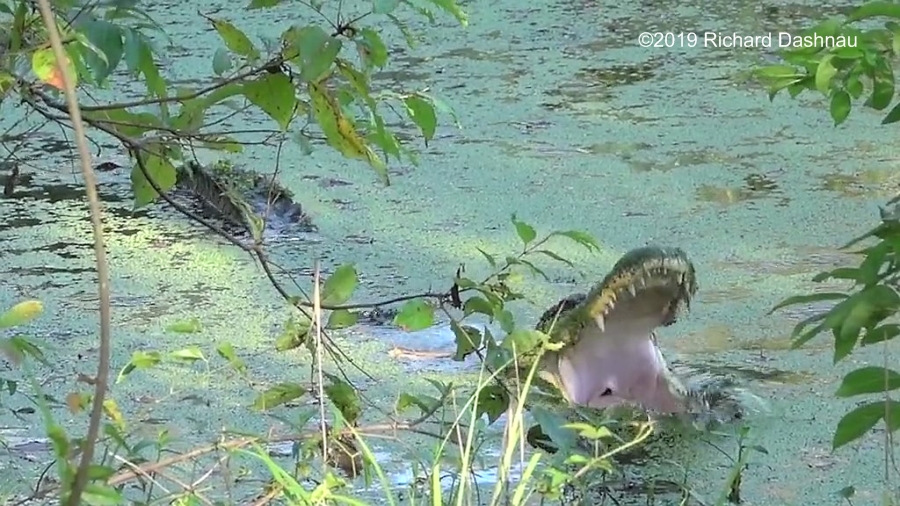
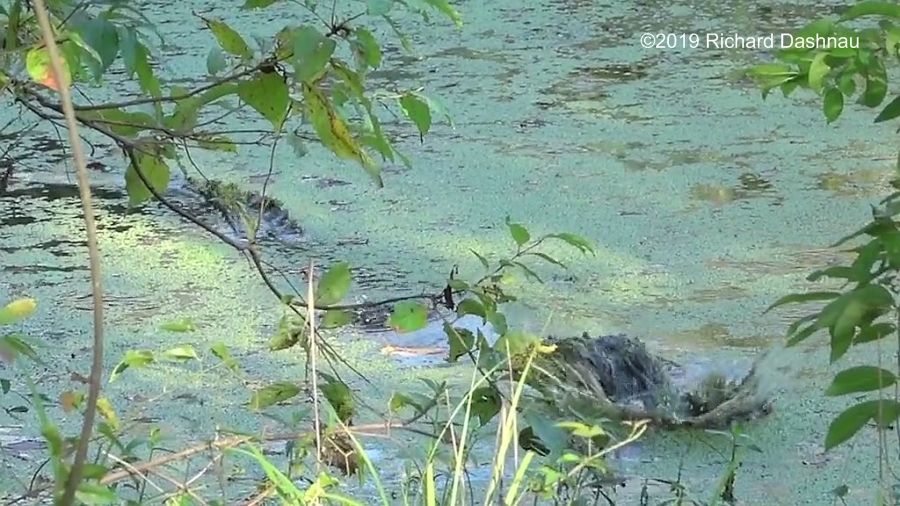
03/10/2019
I was walking along the 40Acre Lake trail when I noticed two
alligators
crossing the lake from the islands towards the North loop of the
trail. One seemed to be chasing the other,
so I hurried around
the bend to see what was going on. I'm always looking for
examples of "agonistic behavior"(interaction
between animals
relating to escalating or minimizing aggression
is called "agonistic behavior").
When I caught up with them, it appeared that there was some kind
of
"low-key harassment" between the two gators . The
"aggressor" would slowly move
toward the "submissive"--which would move
away at about the same pace. When the submissive stopped moving,
the
aggressor would press it again--but not by moving straight
towards
the
submissive gator. That is, it didn't just move close to the
nearest
part of the submissive--it seemed to be trying to move
closer
to
that alligator's head...or possibly trying to "herd" the
submissive by
moving in front of it. I had started shooting video right away
(the
images here are frames from the video), and I moved past the two
alligators and looked back. This was so
I wasn't directly alongside of
the confrontation in case one of them decided to leave the water
to
escape the other. I've frequently observed
submissive
gators leave the water while being
threatened by another gator;
if their path to deeper water-and escape that way-was blocked.
As I
watched, a slow-motion "dance" unfolded as the aggressor moved
past and
around the
submissive, who-in turn-would move away a bit. Then the
aggressor would close in, and the dance steps would repeat.
In
some of the images, I've sketched a line which approximates the
boundary between the zones around each alligator.
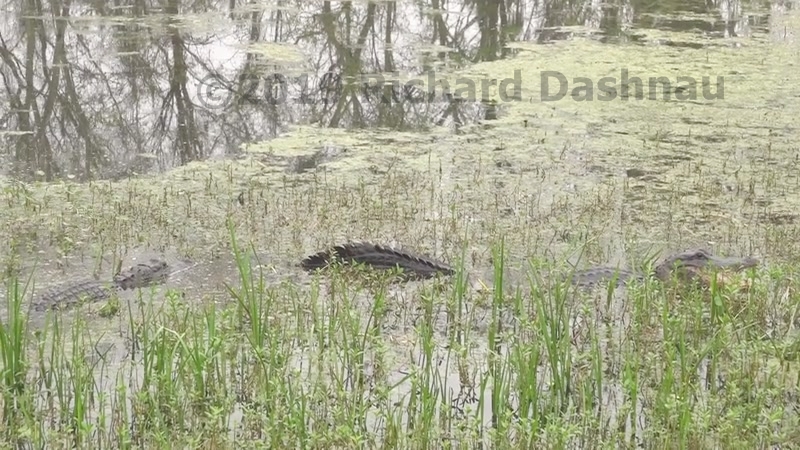
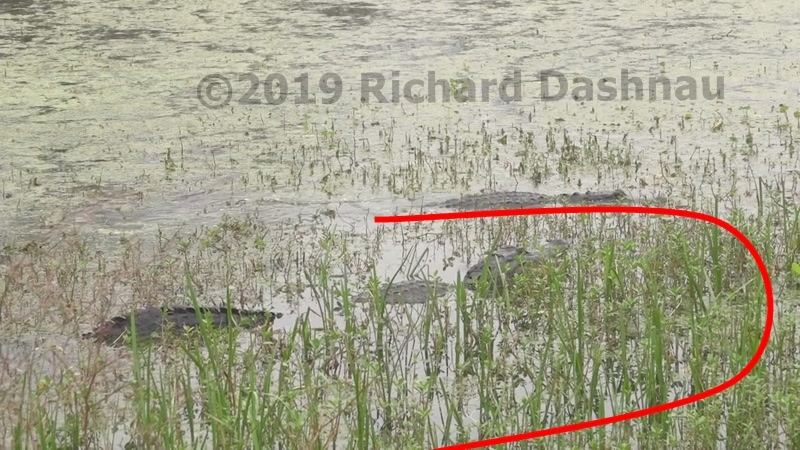
During
all
this, it seemed evident that there was a sort of "zone" around
each
gator-and that all movements towards each other stopped at the
edge of
this "zone". I could imagine the
alligators as two magnets of the same
polarity, and moving one magnet towards the other would
eventually push
that magnet away until the force/distance equilibrium was
restored. The
alligators stayed a similar distance apart during this entire
event.
During
this "dance", the submissive showed a warning stance-tail arched
with
head and back above the water, with the
mouth opened about 1/3 of
full-gape.
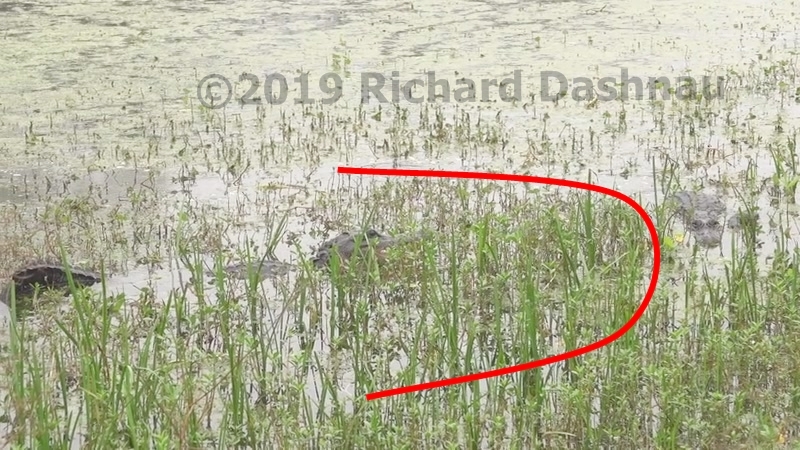
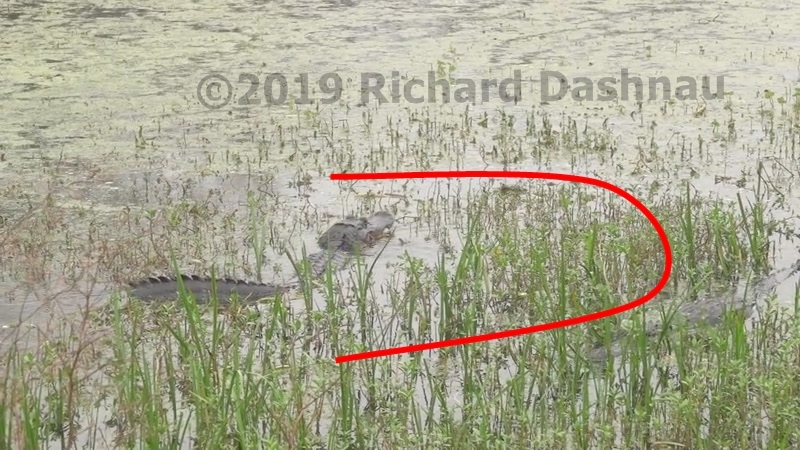
I
call
this a warning stance, but it could also be body-positioning for
a
defensive biting attack. All through the dance, both alligators
moved
with reserve-no sudden, quick movements.
From experience, I know that
quick movement by either gator could precipitate a sudden
escalation of
events--a quick movement to flee could start an aggressive leap
from
the
aggressor; or a quick move by the aggressor could yield a
defensive
bite from the submissive.
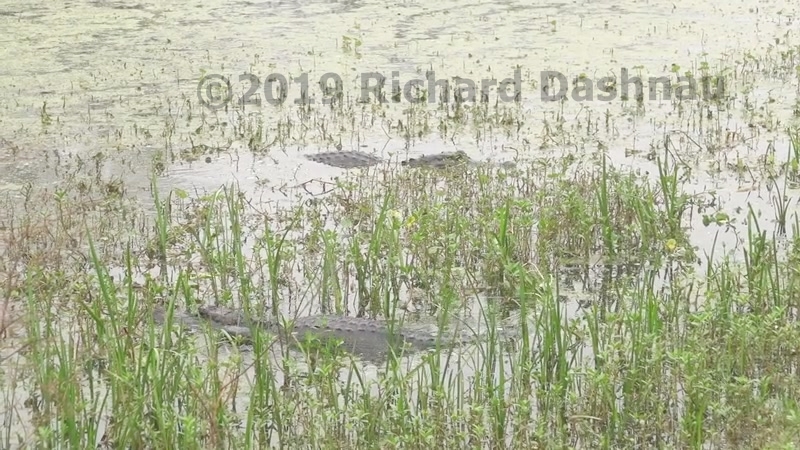
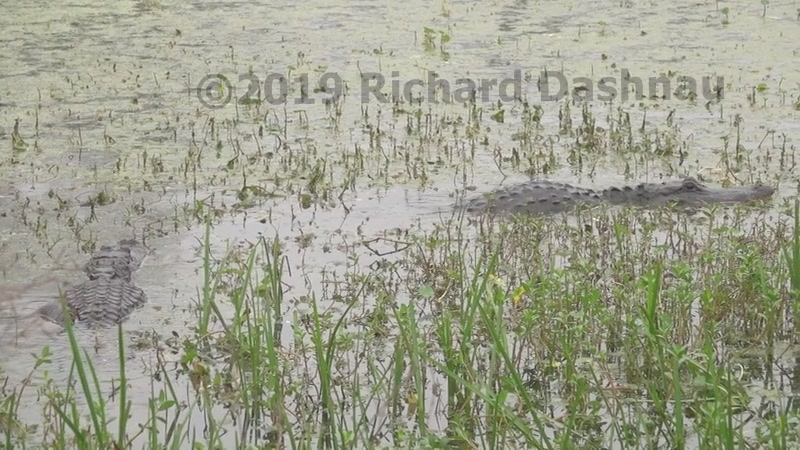
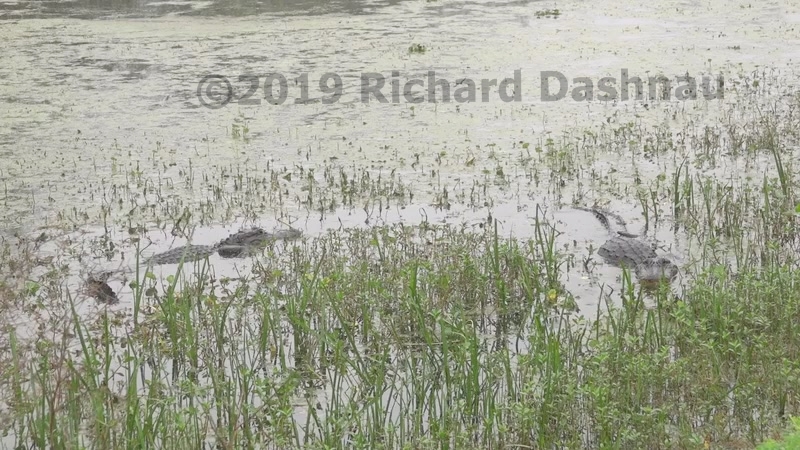
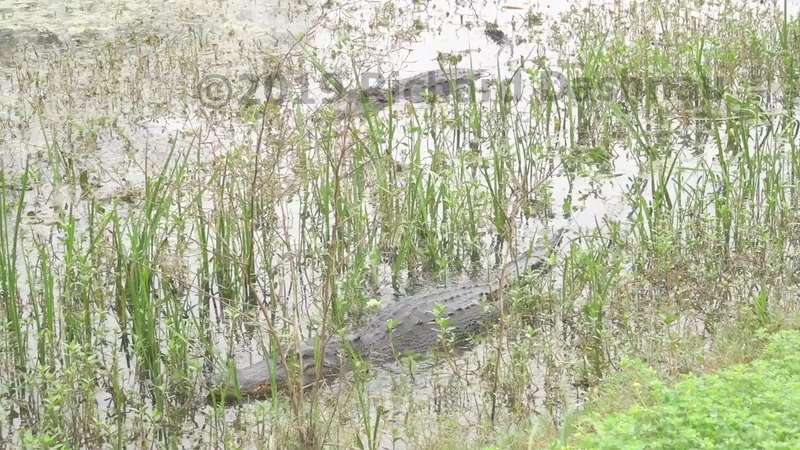
This
slow
dance might have continued indefinitely, but then a new element
was added-by other alligators. Alligators started bellowing
off in
the distance--one somewhere behind me (North of
me) and at least one to
my left (East of me). I knew that if *I* could hear the
bellowing, then the alligators in front of me could, too. So I
watched
for a reaction. I wasn't disappointed. The
aggressor moved near the
bank and started to bellow...right in front of me. While it
bellowed,
the submissive alligator showed no visible reaction.
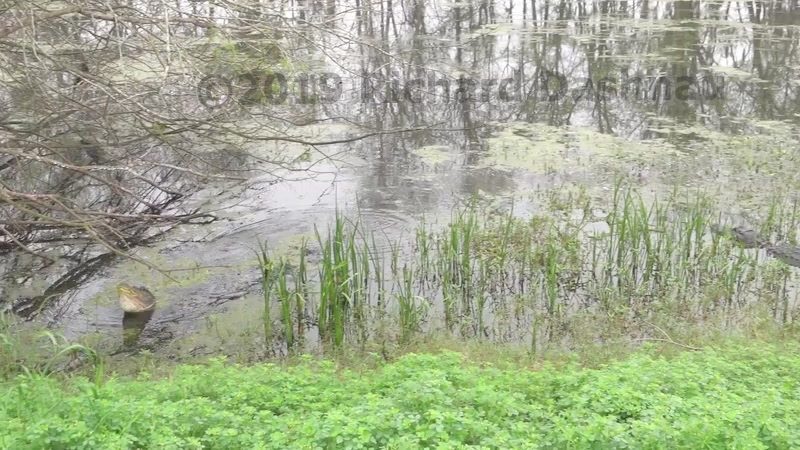
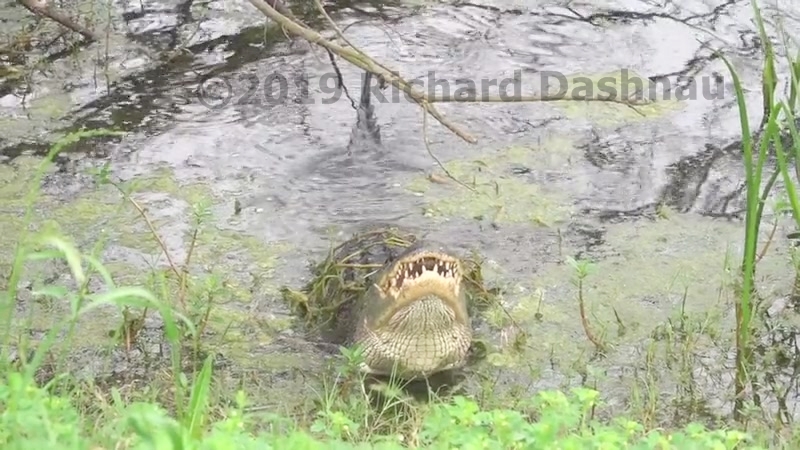
The
chorus
of gators bellowing stopped. A gator started bellowing
somewhere behind me, and the "aggressor" bellowed again.
During
and after this bout, I still couldn't see any reaction
from the
"submissive" gator that was next to the bellower.
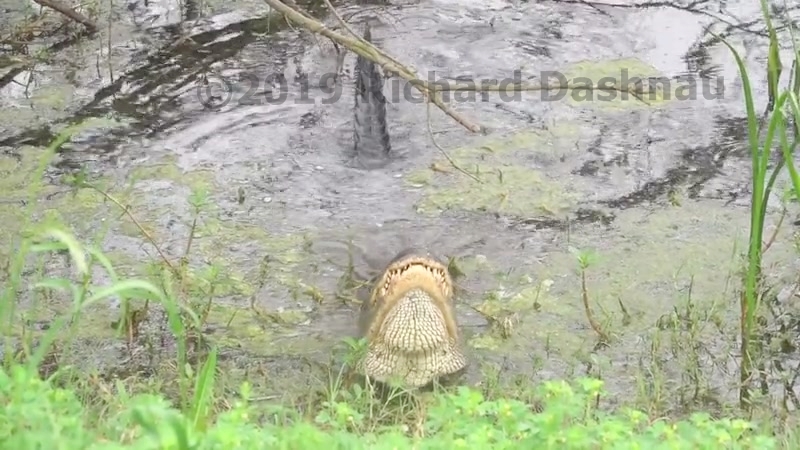
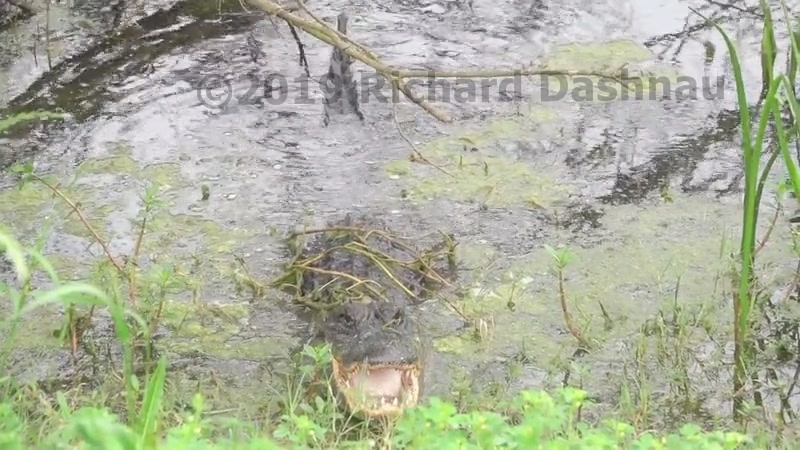
However,
I
saw a possible reaction as another alligator approached from
about 50
yards to the East. It cruised towards the gators in front of me.
The
"aggressor" bellowed again. At the
fifth bellow, the gator
approaching from the East turned towards the edge of the lake,
and
began to form the Head Oblique, Tail Arched position. But the
water was
too deep to allow the
gator to stand. It moved closer to the shore
until it could stand on the lake bottom. Then the
"submissive"
alligator and the newcomer began to bellow--while the
"aggressor"
continued bellowing.
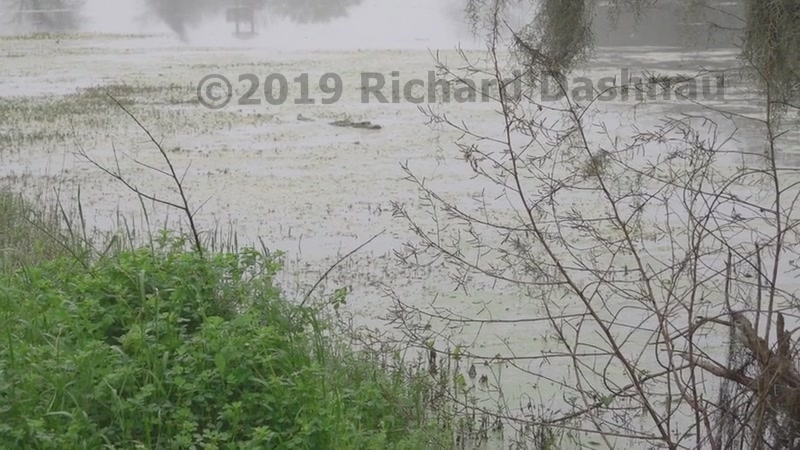
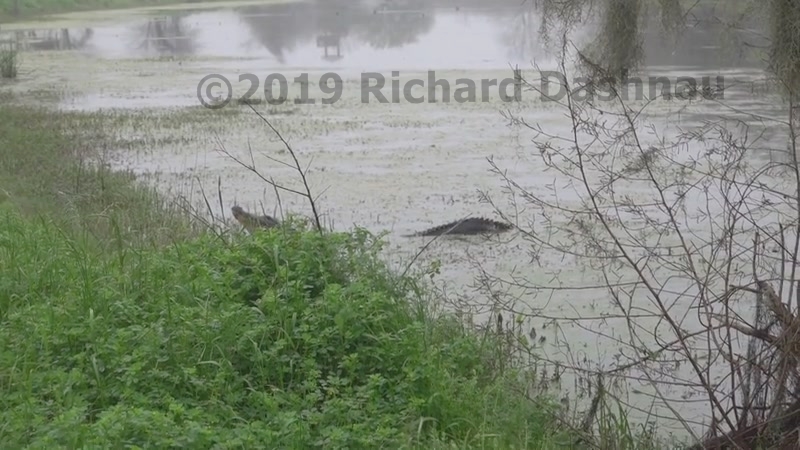
For
a
few minutes I was treated to 3 alligators bellowing right in
front of
me! The events described here took about an hour, and I
filmed
during most of it. The edited video
can be seen
here.
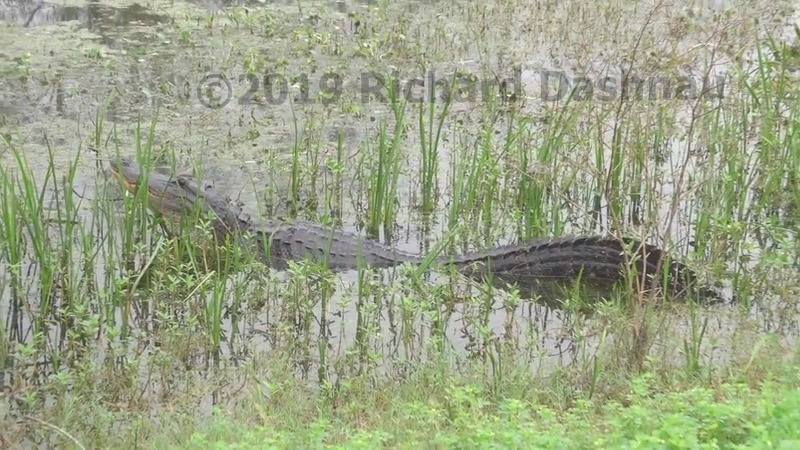
When
I
reviewed the footage, I noticed that when the two gators in
front of
me bellowed; there was no "water dance" over the back. This
"water
dance" is caused by a low-frequency
"fluttering" of the surface of the
back. The fluttering causes "sub audible vibrations (SAV)" which
can be
felt by other gators(or even by me-through my feet-if I'm
standing
close enough).
According to one
study:Social Displays of the American Alligator (Alligator
mississippiensis) by Kent A. Vliet 1989
"The bellowing cycle for female alligators differs somewhat
from
that
of males. Female alligators do not produce the SAV
signal and
the
audible bellow of the female is produced as the animal lowers
into the
water following inflation of the lungs."
(page 1021) I've directly observed-and read
elsewhere-that female alligator bellows sound different from
that of a
male.(Alligator
Reproduction:Courting, Breeding, And Nesting
Behavior by Ted Joanen
and Mark Merchant; in American Alligators-Habitats,
Behaviors
and
Threats ed. by Scott Henke, Phd and Cord Eversole, PhD.
"Although both
sexes bellow,
the vocalization produced by males is lower in frequency
and louder than that produced by females, which tend to be
higher
pitched and less percussive." (p.98)) The
bellowing
cycle
for female alligators differs somewhat from that of males.
This
study indicates another difference. I can safely assume that the
two
alligators in front of me were females ( I
couldn't clearly see the
newcomer's back, but it sounded a bit deeper.). So it's
possible
that this competition-or whatever it was-happened between two
females!
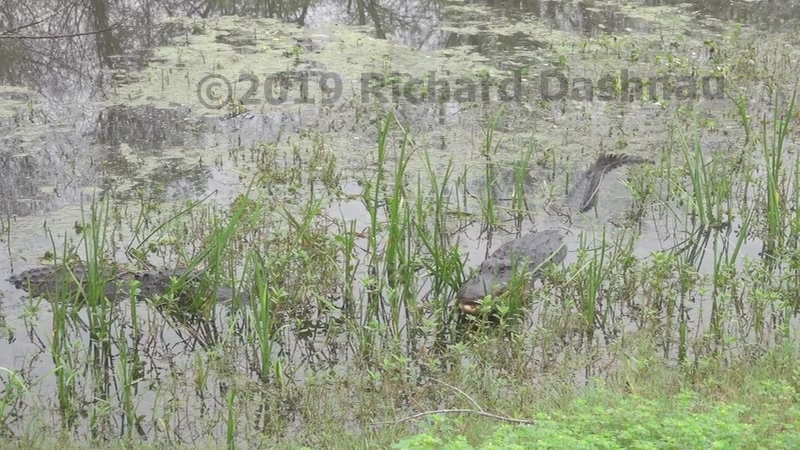
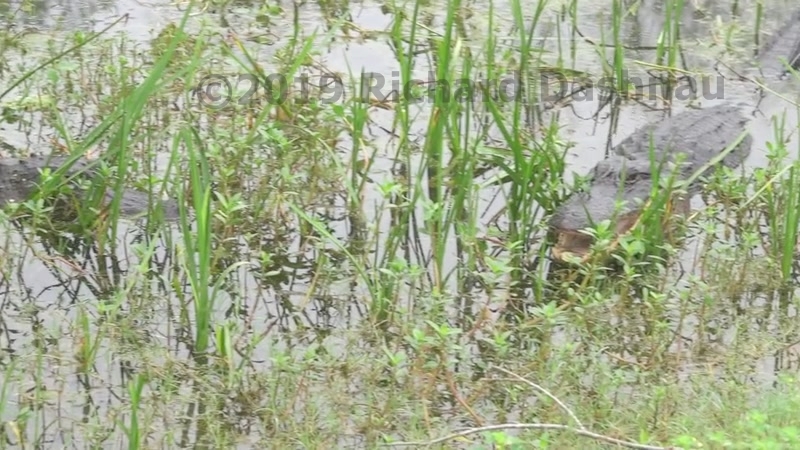
The
"aggressor"
started moving toward the "submissive" before the
submissive had stopped bellowing. The submissive resumed its
partial-gape stance. The two gators remained
in this
confrontational situation for a few minutes. Then the submissive
gator
slowly backed away, turned around and swam back towards the
islands,
and the aggressor followed.
And, to repeat, the
edited video can be seen
here.
02/18/2018 . It
was warmer than usual this morning. At about 10:50am, I
was
near
the West end of Elm Lake when an alligator started bellowing
near one
of
the islands. Another answered...and then for about 15 minutes
there was a chorus of at least 6 alligators bellowing in Elm
Lake.
A few minutes after the chorus
ended, an alligator that was in
Pilant Lake, just across the trail from Elm Lake, began to
bellow.
The images below are frame grabs from the video clip that
I
shot.
View the video clip by clicking this
link. It's
a bit early for mating season (which is March - May) but perhaps
this
was alligators claiming territory. Or...alligators
have been
observed bellowing off-season (such as in the fall) when a warm
front
has come through. Note the group of leeches that are attached to
the
underside of
the alligator's jaw!
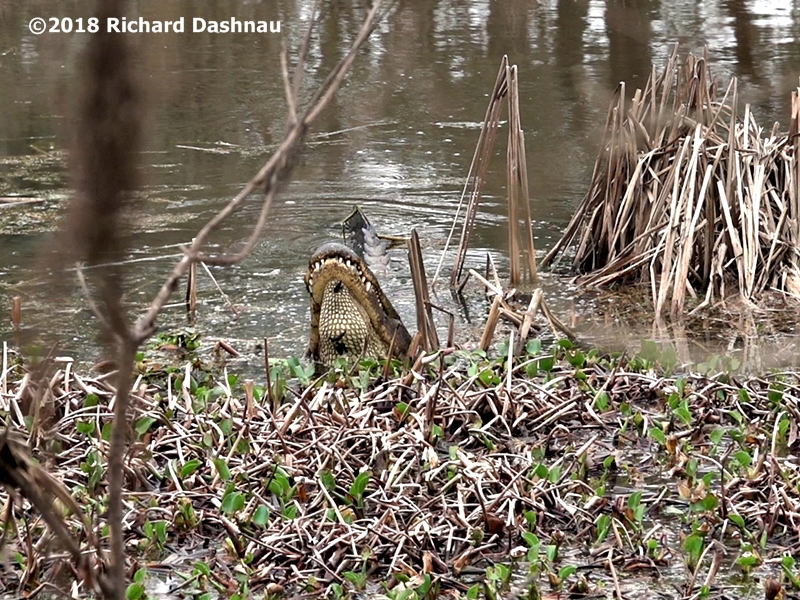
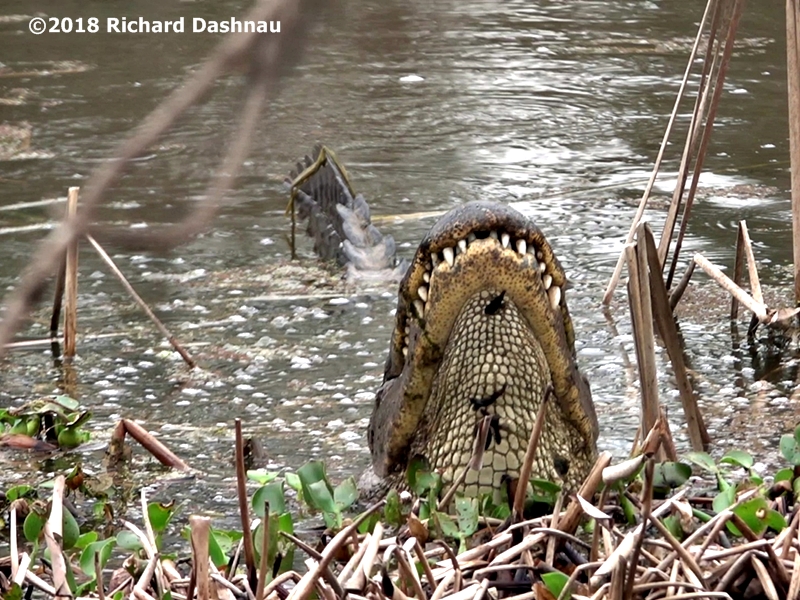
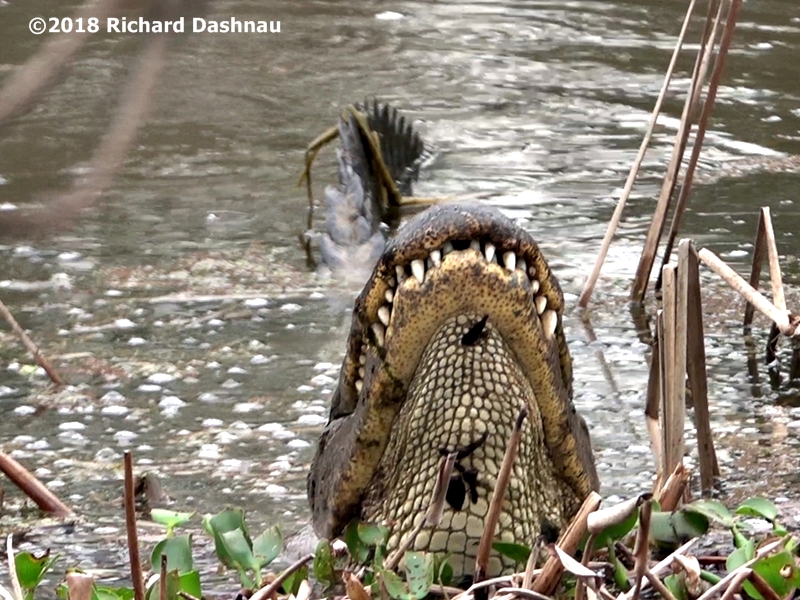
About
15 minutes later, I watched two alligators that seemed to be
competing
for a basking spot. There was a brief chase, and then both
alligators
eventually
crawled up and basked, but about 10 feet apart. The images below
are
frame grabs from the video clip I shot of the action. To see
video
clip click on this
link.
It was
interesting how both
alligators' heads and upper bodies rose out of the water--nearly
at the
same time. The slowed-down
video shows that the pursuing alligator accelerated first.
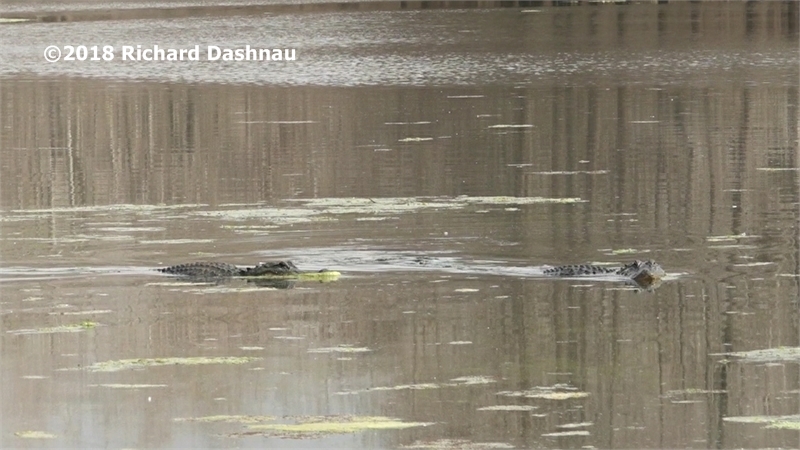
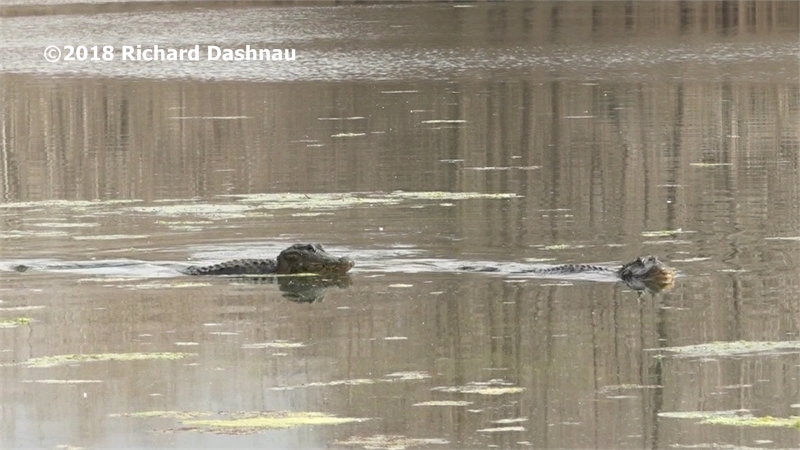
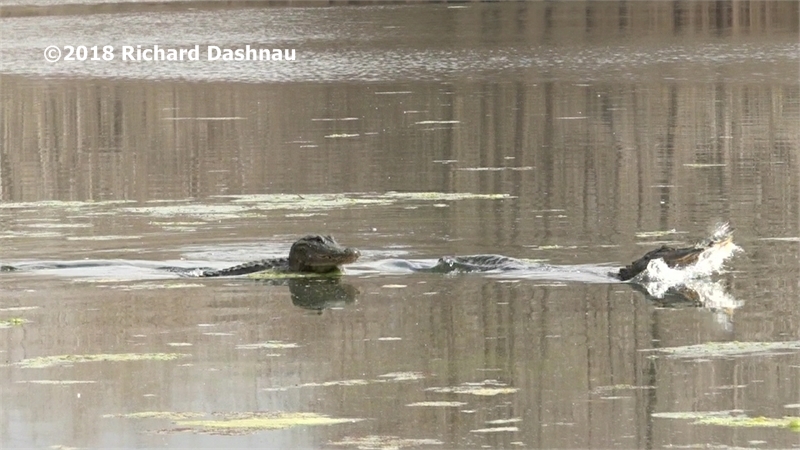
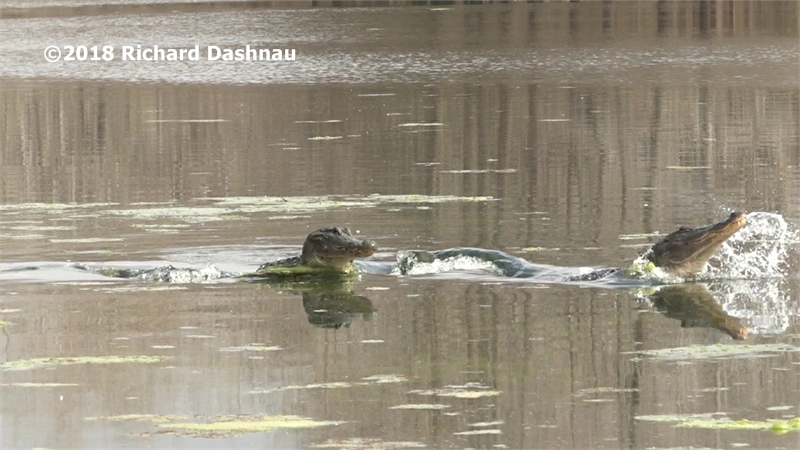
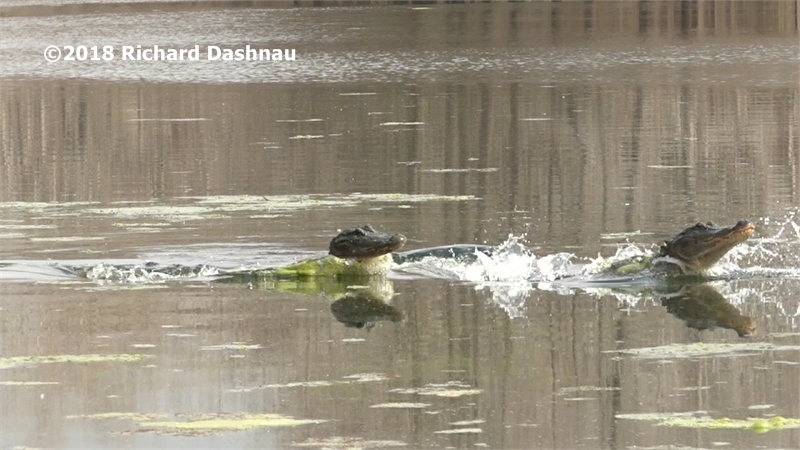
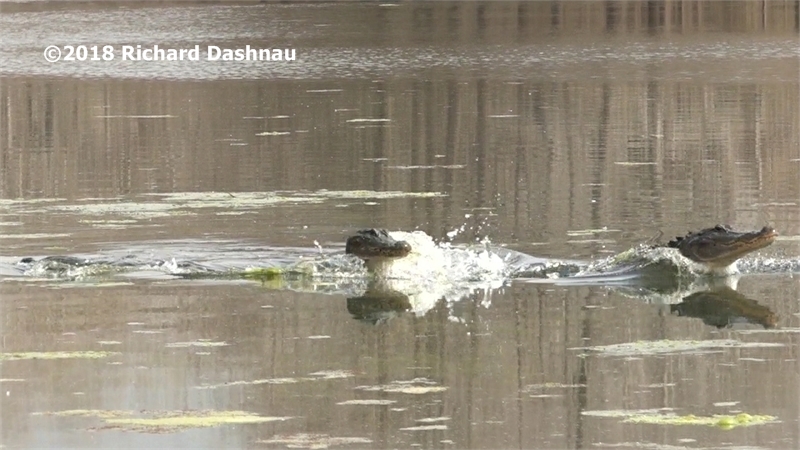
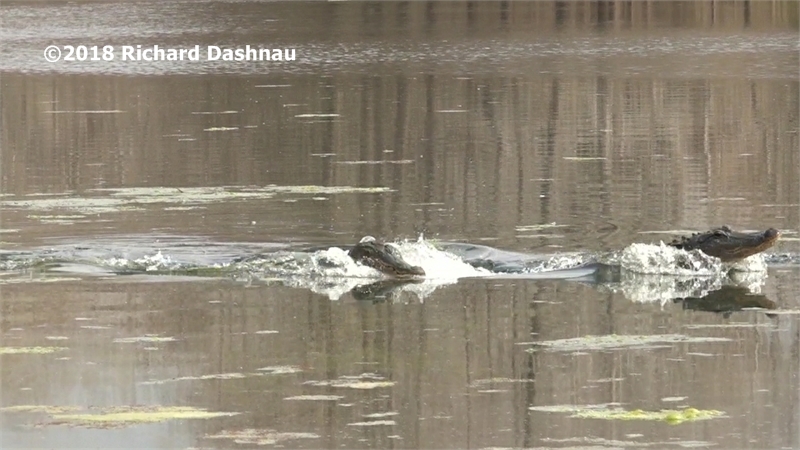
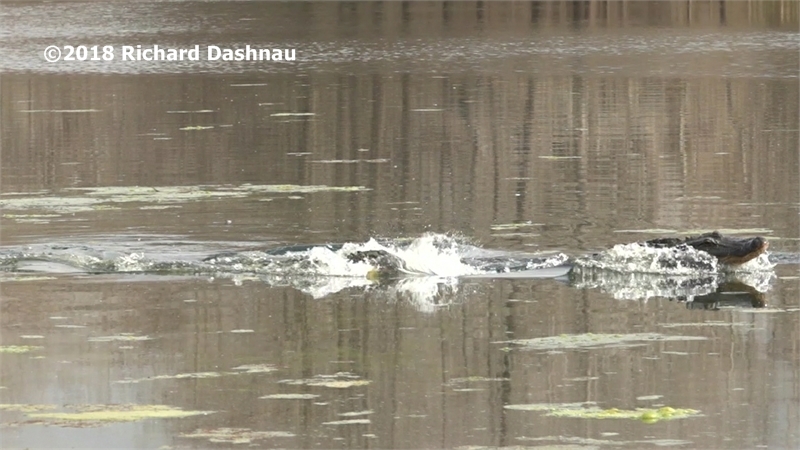
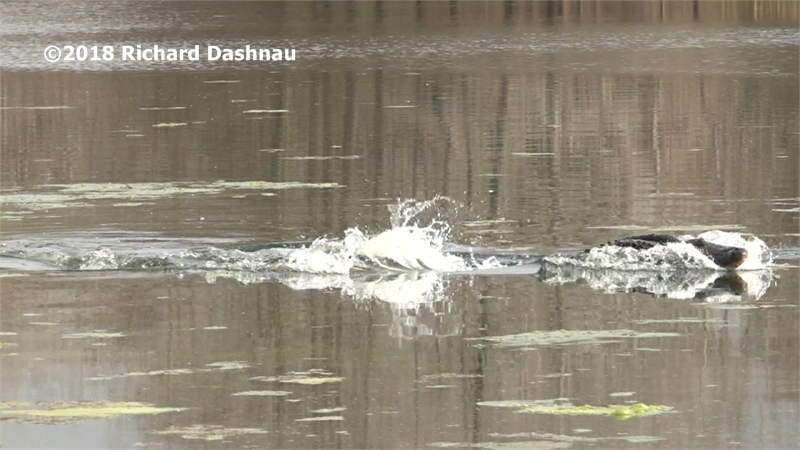
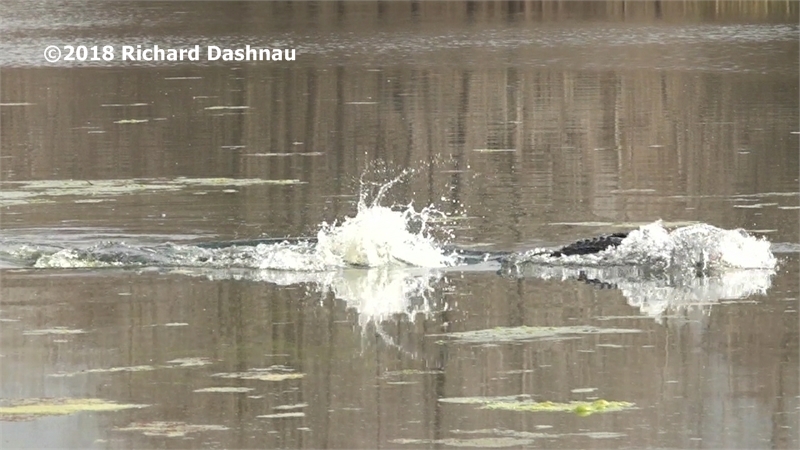
07/12/2015
Brazos
Bend State Park reopened 4 days ago! Some
of the park is still not
accessible, but the park is open. I was happy to be on the trails. I
heard more
than one
chorus of alligator bellowing starting around 9am. The usual
mating season has passed (March-May). The June nesting was probably
disrupted by the flooding
of the park. But, 2 alligator nests were
built between the 2 flooding events. They were built very close to
each
other, on what was most-likely some of the only bare dry
ground
available. I'm guessing that the bellowing could have been
started
by females, possibly claiming nesting sites (I've commented on this
before--but haven't read
about it anywhere. It seemed to me that
most of the choruses that started in June appeared to be started by
female gators--but I'm only guessing because of the
different, higher
pitch of the calls.) OR--another guess:
The alligators have moved
around the park, and even "new" gators could have entered the park
during the few weeks of very high water. The bellowing alligators
could
be establishing new territory. I know that at least one male
alligator is back in his normal "territory". This one is about 9
feet
long, and is one of the few alligators that I
can actually identify.
I've got pictures of this alligator elsewhere on my pages. The
prominent "mark" is shown in the first 2 images below. There is a
white
protuberance
on his back, centered in a spot that is missing some
osteoderms.
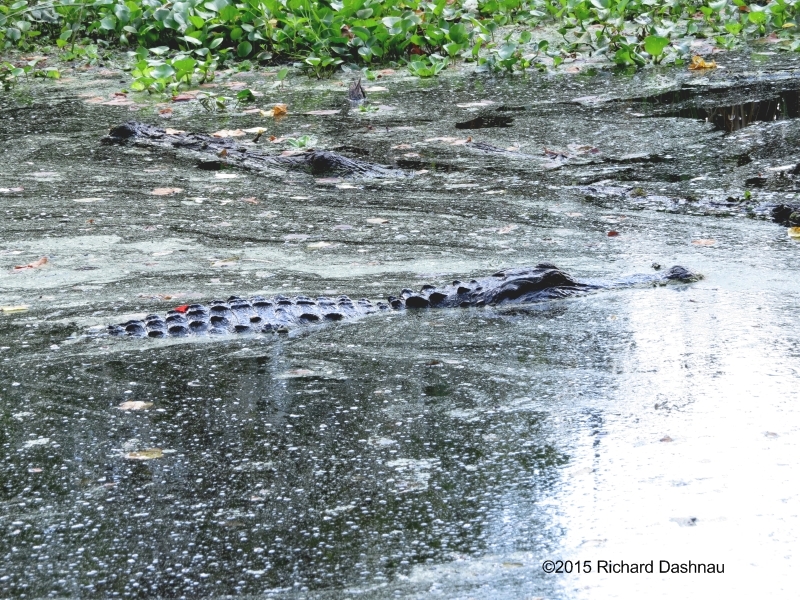 --
--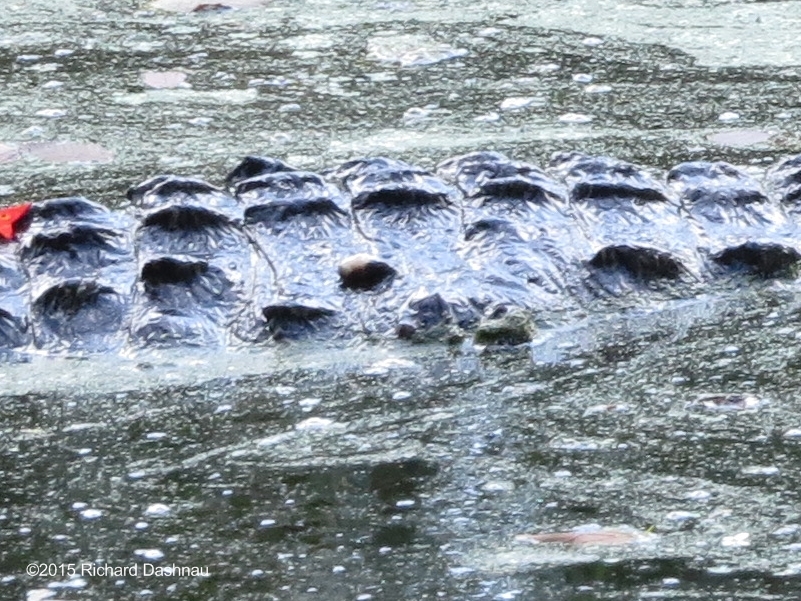 -
-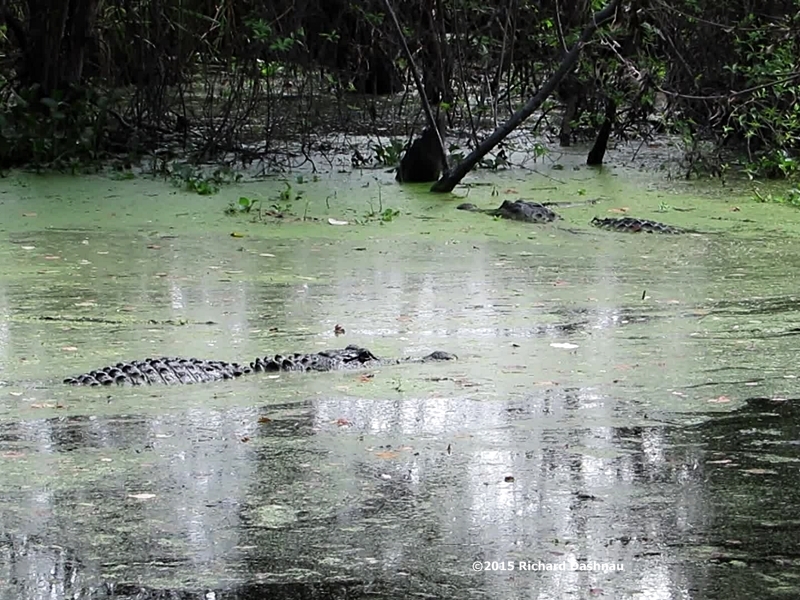 --
--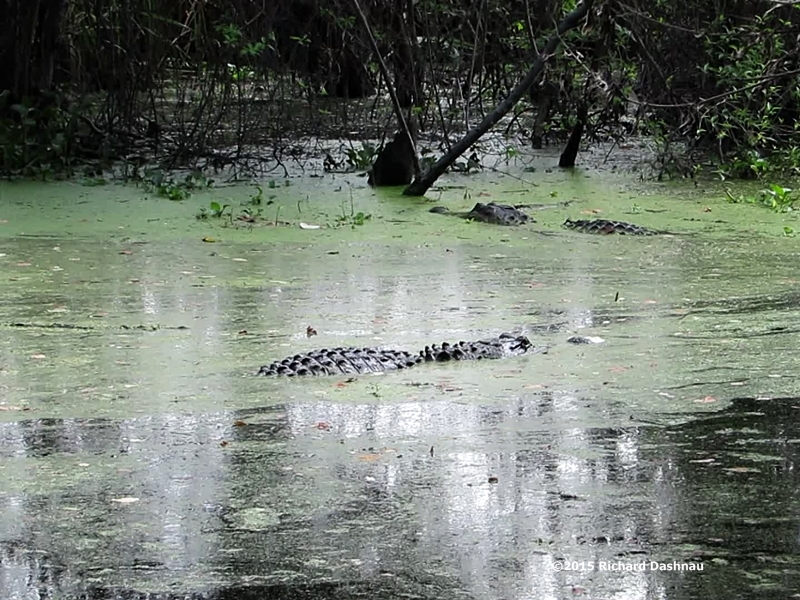
Large Spillway
Male swims East
Close-up showing the white "bone".
"New" male from
left. "Old" facing tree.
"New" male continues moving.
I
followed the male (I will call this one "Old" male because he was
there
first) as he patrolled; leisurely moving East. Then he stopped,
about
50 yards East of
the
Spillway Bridge. While I watched him, I heard a head-slap from the
direction of the bridge. (I found out soon after that the alligator
that made the sound
was behind the bench just East of the Spillway
Bridge. The "Old" 'gator immediately responded to the sound by
quickly
turning and swimming West. Then he slowed,
sped up again, then
slowed and turned towards a bank. Meanwhile, the alligator that had
done the head-slap ("New" alligator) began moving East
(towards the
"Old" 'gator).
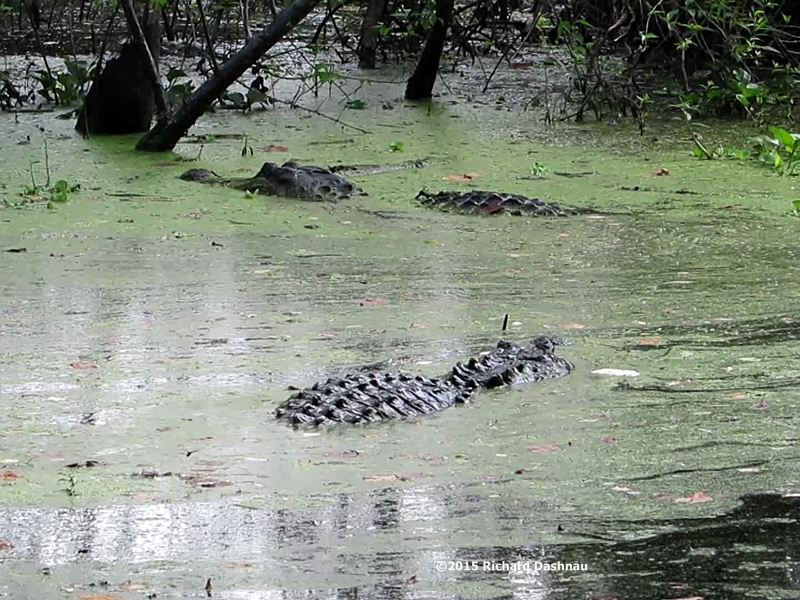 --
--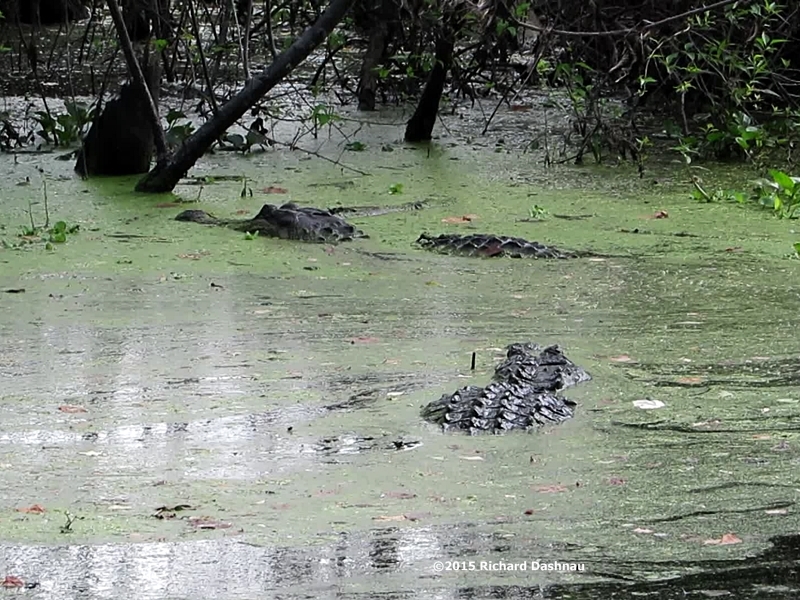 -
-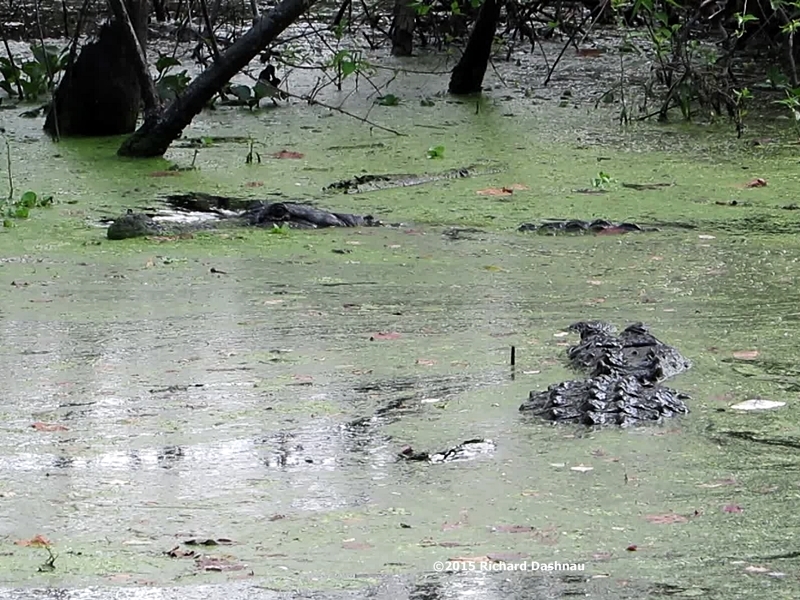 --
--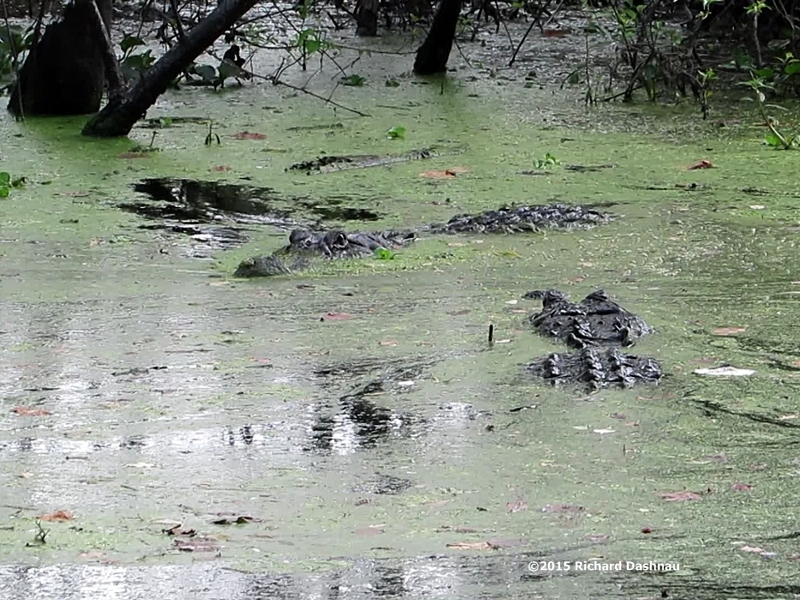
"New" male turns towards
"Old".
"New" male moves slowly toward "Old"
"Old" male turns towards "New".
"Old"
male keeps turning towards "New".
"New"
'gator was in obvious visual distance as it continued swimming East;
and I thought that it might swim past "Old" 'gator. But, it turned
towards "Old"
gator, and then slowly...slowly began inching
towards it (Actually, alligators that make that decision to closely
approach another will usually do that slow approach.)
In this type of
interaction, if only one of the alligators is moving towards the
other;
then the stationary one will finally have to make a
decision--usually before
the
moving alligator touches it. Sometimes it submits slowly (by turning
away; or submerging) or submits quickly (by a sudden quick retreat
or
dive) or it might
NOT submit and may turn and rush at the approaching 'gator.
But...usually it will do something
before the approaching 'gator touches it.
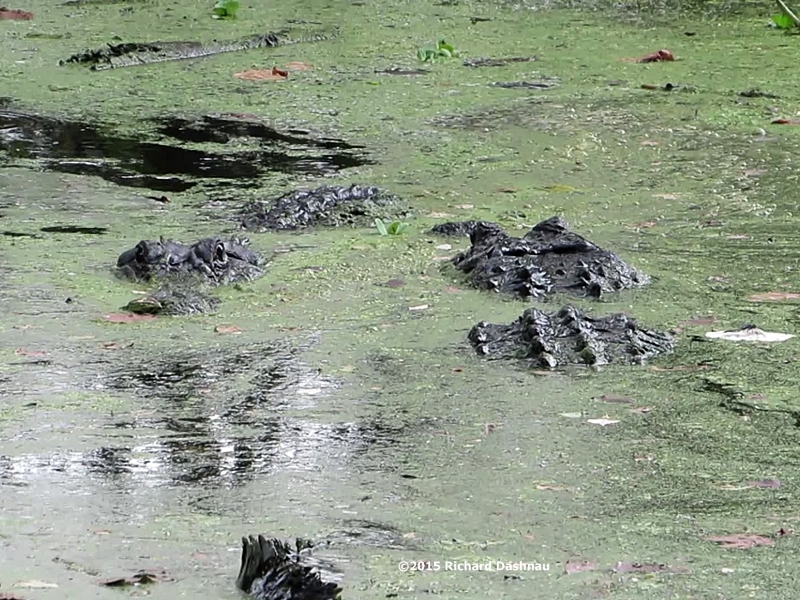 --
--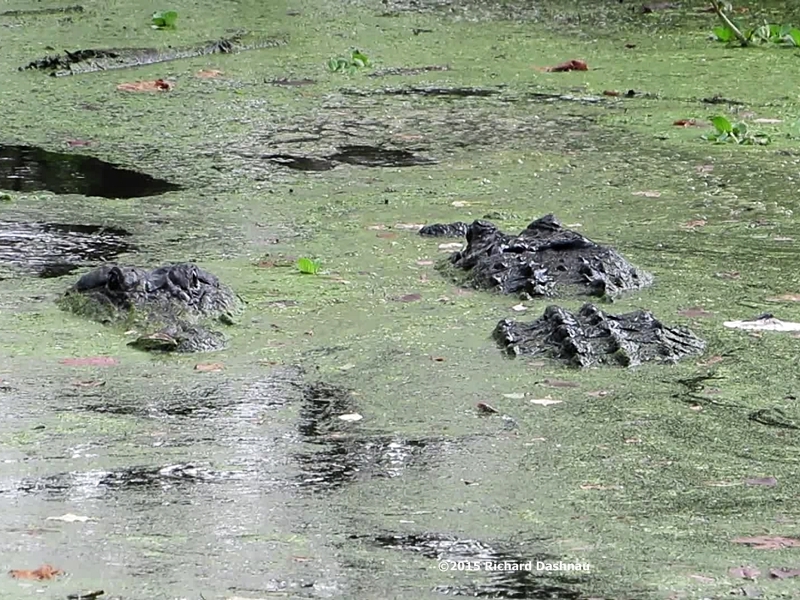 -
-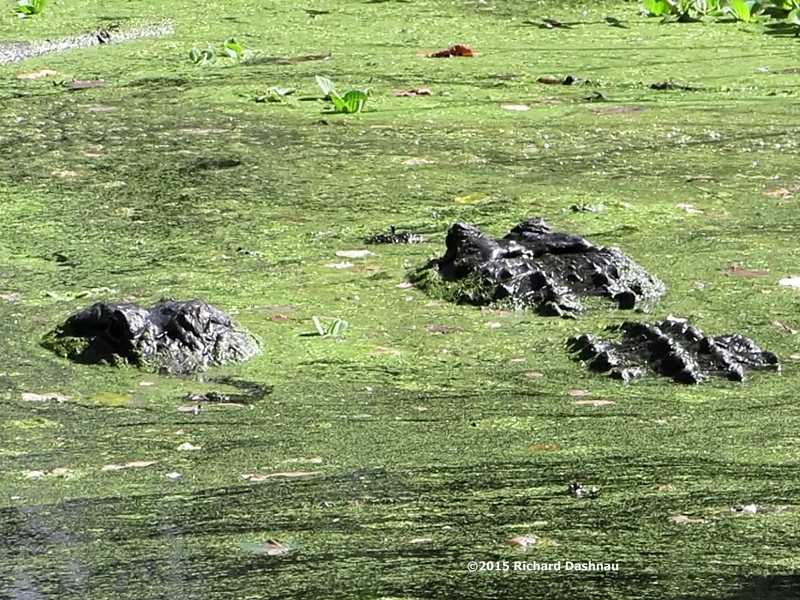 --
--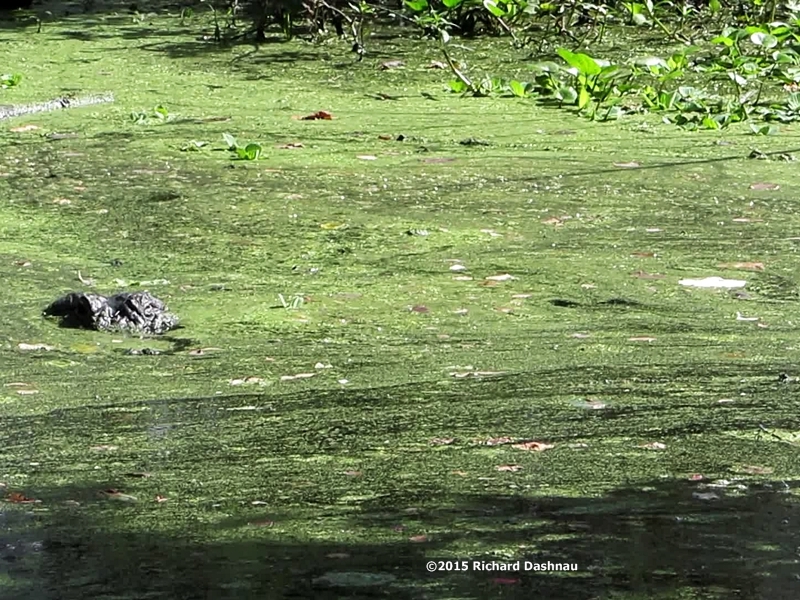
As "Old" male turns "New" briefly lifts tail.
"Old" and "New" watch eye - to
- eye.
Staring contest continues.
"New"
male submerged.
In this situation,
they began a staring contest. The two alligators were very
close
in size. There was no tail thrashing, no snout bubbles, and
no
tail-arching or
exposure of the entire back. I thought the "Old"
alligator was going to submit as it very...very...VERY slowly seemed
to
submerge. Its nostrils went under and
I though it would continue--but then the nostrils surfaced again.
Then
I was surprised when the "New" alligator submerged. I
couldn't see
that it moved anywhere and I waited another 5 minutes and he never
resurfaced.
Then I had to leave, because I was signed up to work in
the Nature Center. So, I don't know if anything else happened
between these two alligators.
I thought this was a good example of an interaction between
alligators.
I have seen many interactions in 12+ years ; and most
of them start
out with the same
cautious approach.
If
my first notice of interaction between gators seems like it was
aggressive, I believe it's because I haven't seen the beginning; but
have come in on a later stage.
I've have made this point before,
and I use it during my programs: Alligators have been around
a
long time, and they have relatively small brains. But even
Alligators
know enough to treat alligators with respect and to give them space.
In just about any "bad
" human/alligator situation the fault is with the species that
can read--that is read warning signs, or read state laws regarding
Alligators. Like
I say on my t-shirt "ALLIGATORS CAN'T READ--BUT THEY DON'T HAVE TO."
----------
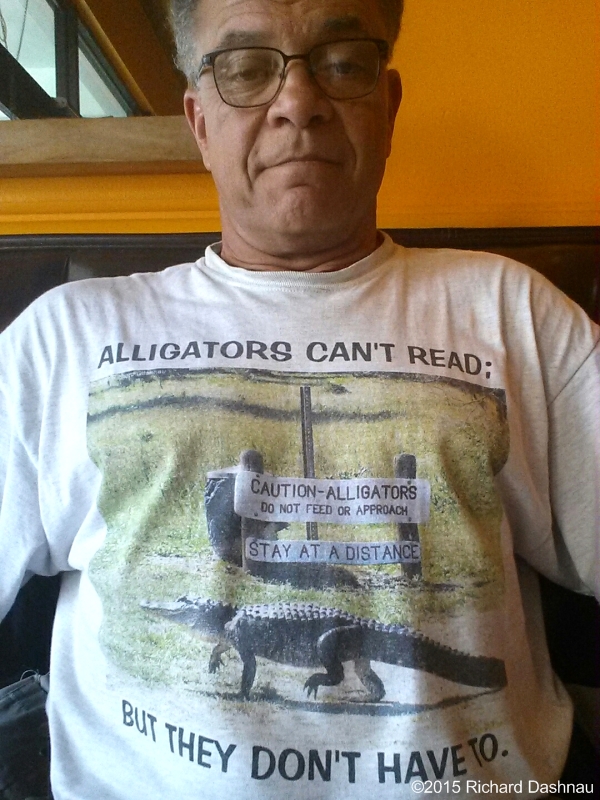
April
28, 2013
On Saturday, 4/27/2013 there was rain
at Brazos Bend State Park. David
said
that a very large alligator tried to cross the grass near the
Nature
Center
from Pilant Slough, probably on the way to Creekfield Lake. But,
a number of visitors were taking pictures, etc., so the alligator
turned around. Later that evening,
David saw the alligator on the road,
moving in the same direction, and he made sure it crossed
safely.
The distance from Pilant Slough to Creekfield Lake is about
275 yards.
Alligators occasionally go to and from Creekfield lake. Distances
are
measured using the google
maps
distance calculation tool.
Creekfield Lake is
about 295 yards long and about 95 yards wide.
Its long axis is roughly North - South. The map images are
from
Google Maps.
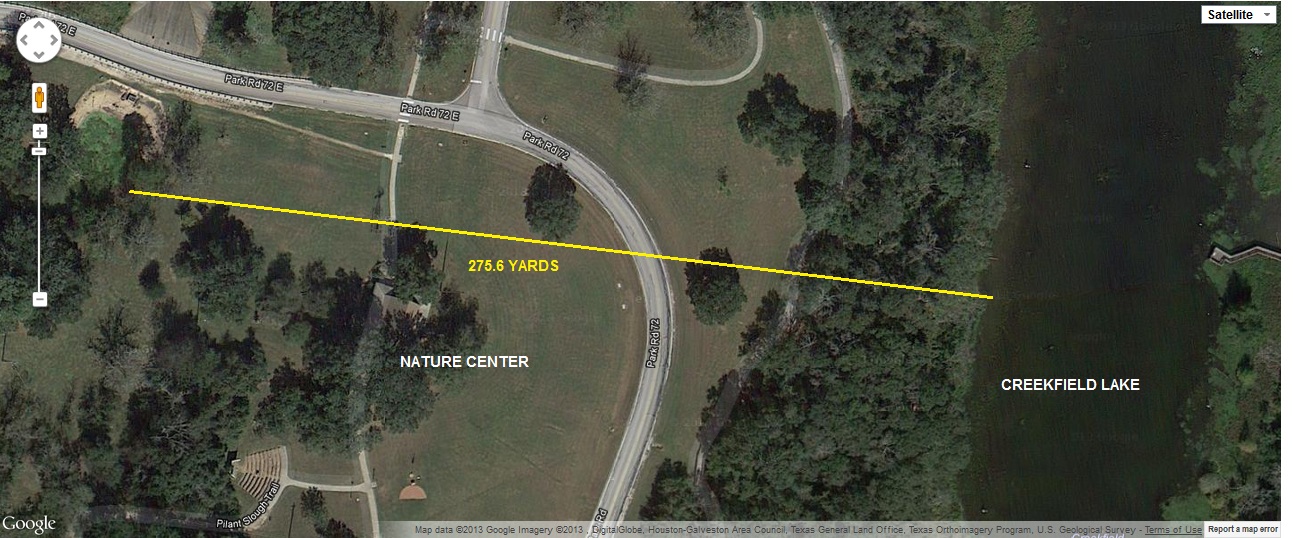
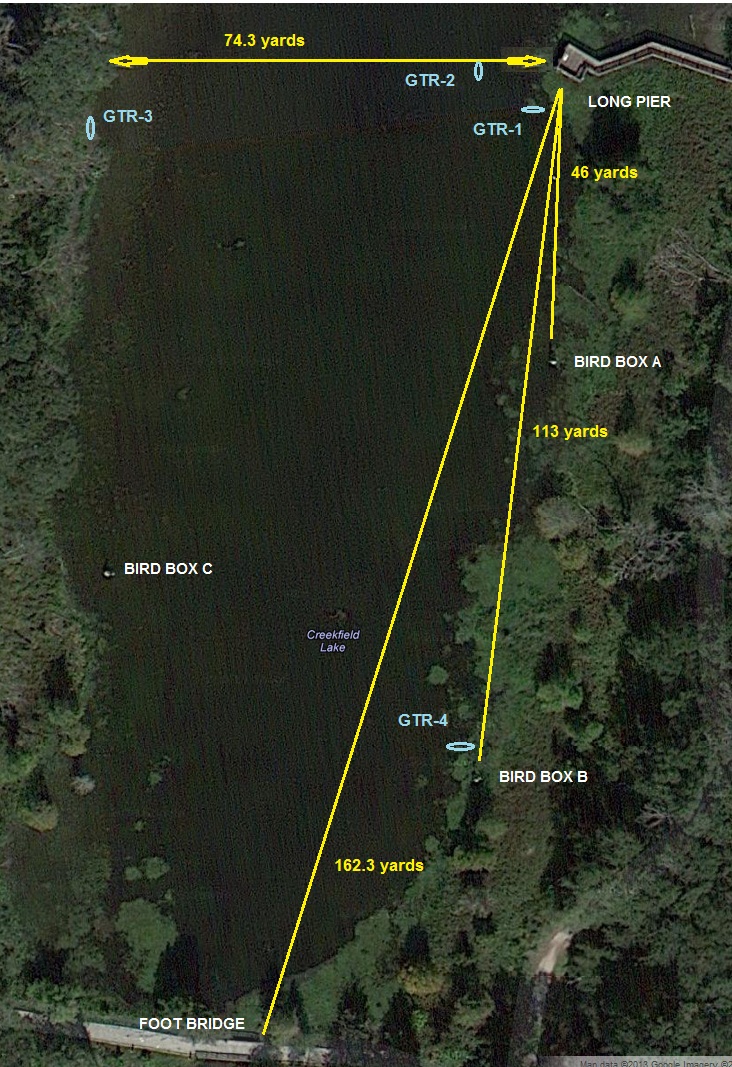
When
I heard the story the next day, 4/28, I went to Creekfield lake at
about 11am to see if the big alligator was there. It was. It was in
the
water not far from the long
pier. I went on to the pier to watch it for
a while. I noticed a smaller alligator in the water about 10 yards
in
front of it. Both alligators were just resting in the water.
The
smaller alligator eventually turned and swam towards the far shore
of
the lake, towards where another alligator was already basking about
100
yards away. From the
platform of the long pier, there is a bird
box South, about 46 yards. Another box is beyond that one,
113
yards South of the pier. There is a box Southwest of the pier,
108 yards. All of the "wide screen" images are
frame grabs
from the video that I filmed of what transpired. The edited video is
here(mp4) .
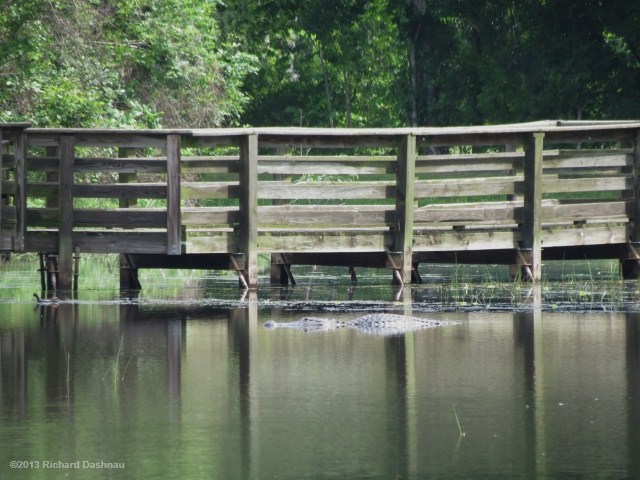
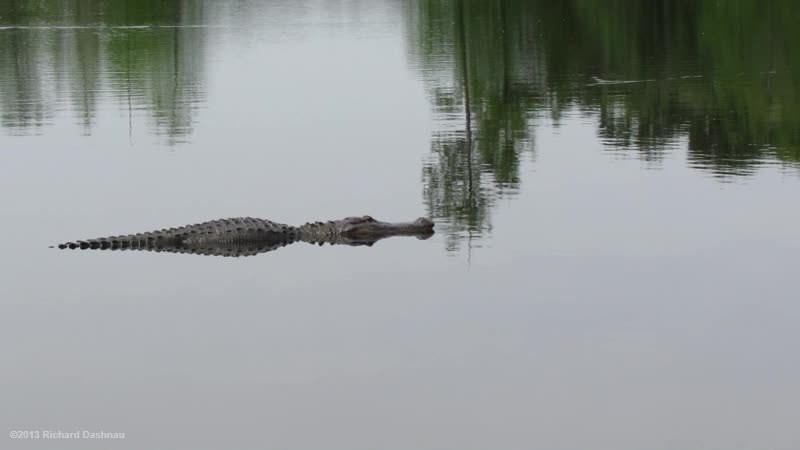 _
_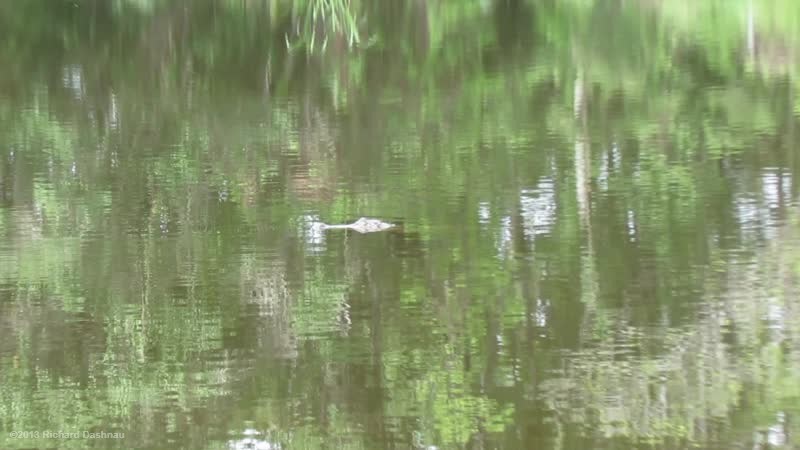
I was relaxing,
taking pictures of the large
alligator, when I heard a loud splash across the lake, in the
direction
that the other alligator had been swimming. When I
looked, the
alligator on the bank had its mouth open, and was doing a "slow
thrash"
with its tail. It was still on out of the water--and I assumed it
was
the same alligator
that had been on the bank before. Another
alligator was in the water in front of it, probably the one that
swam
across.. There was also a large alligator on a small
island out
past the second South bird box--about 113 yards away. The
alligator
moved off the bank, and swam towards the alligator in the water.
That
alligator turned,
and swam straight away from it. The pursuit
continued, slowly increasing in speed until both alligators produced
a
conspicuous wake.
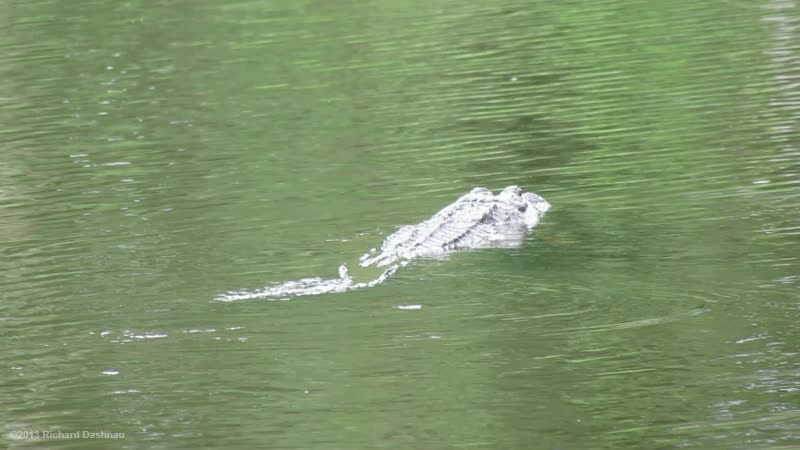
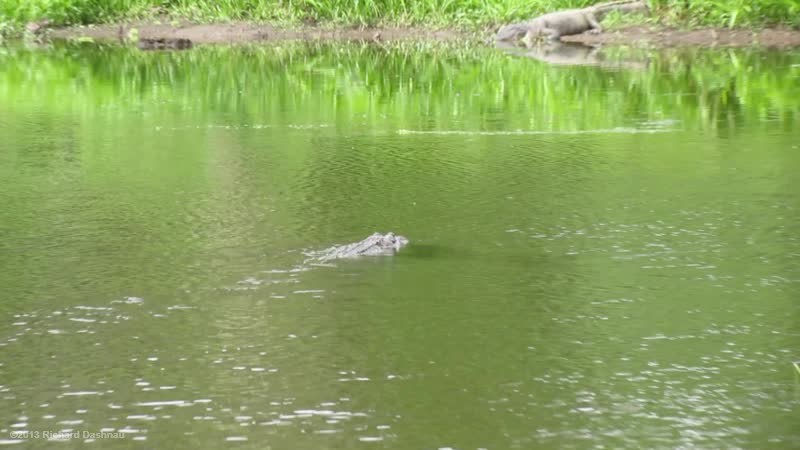
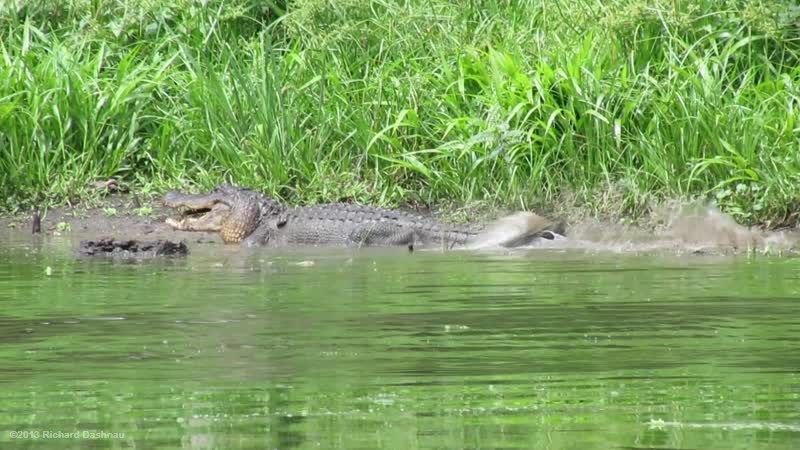
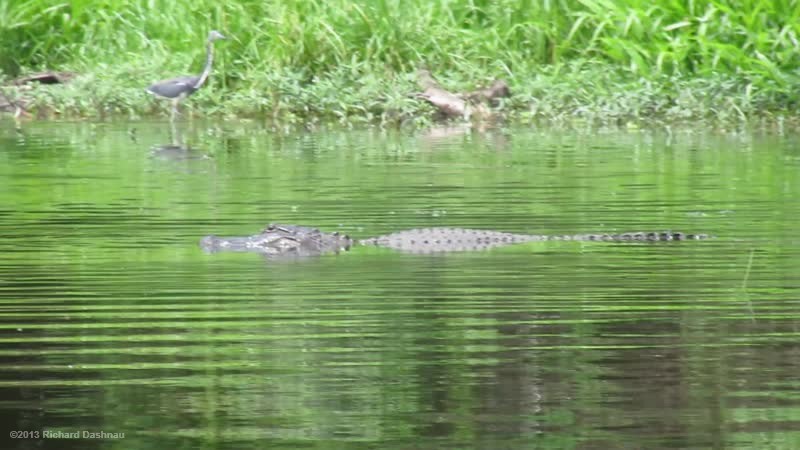
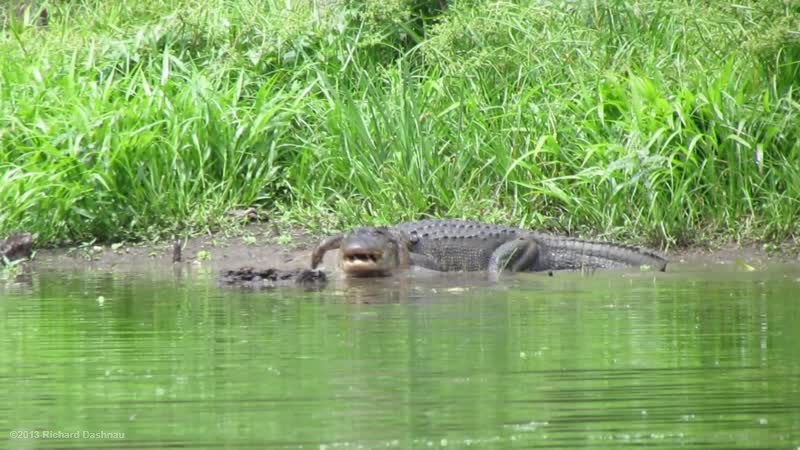
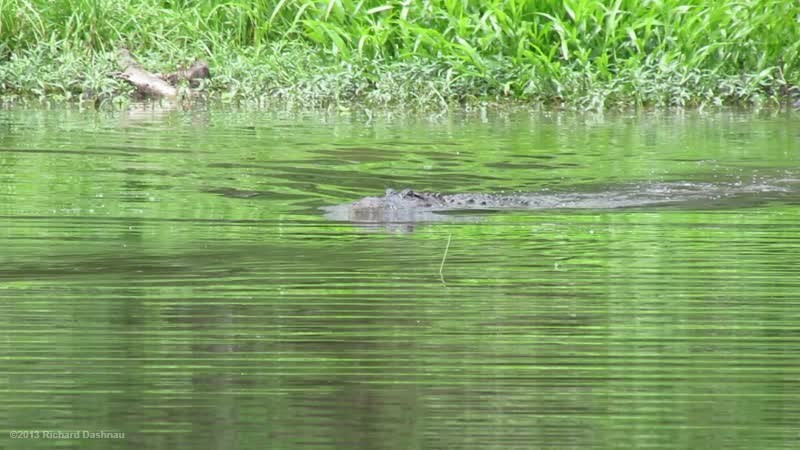
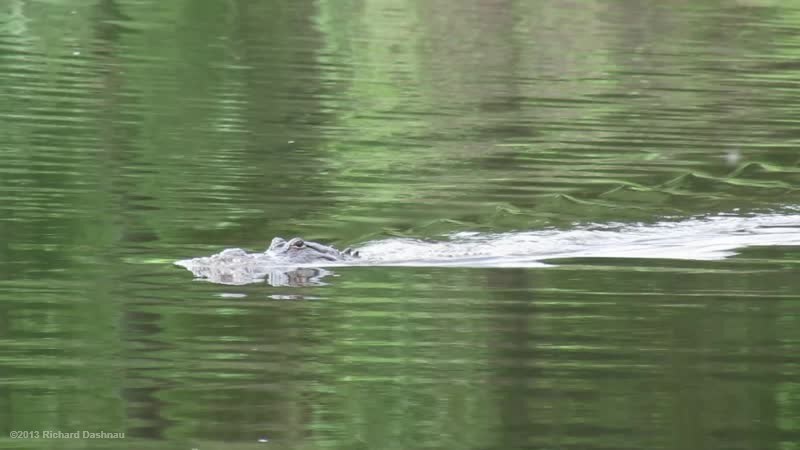
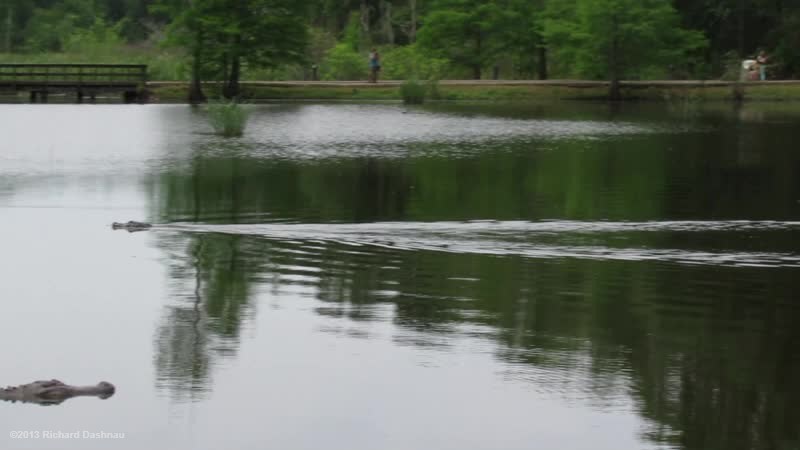
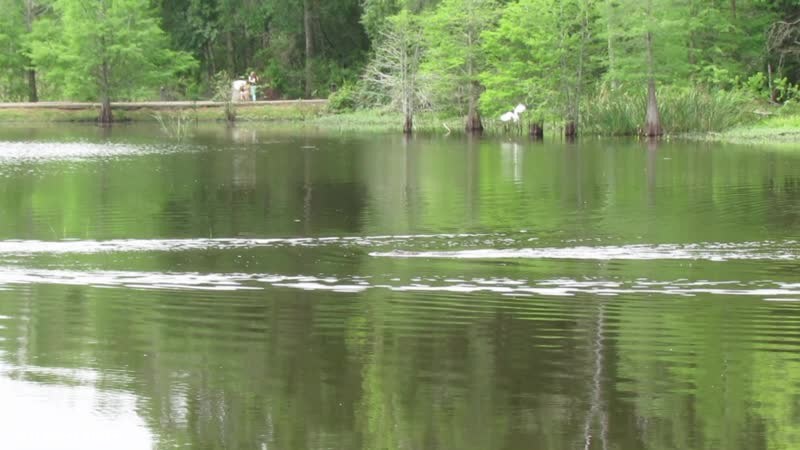
The pursued
alligator swam straight, and passed on my
side of the near bird box. It moved into shallow water. The chase
gator
stayed a bit further out, then slowly
moved in. The pursued gator
finally "breached" out into the shallow water, and moved out of
sight
to me (behind a tree). The pursuing alligator then started chasing
a
much smaller one which I hadn't noticed before. The small alligator
moved into the deeper water, and eventually submerged and swam
away.
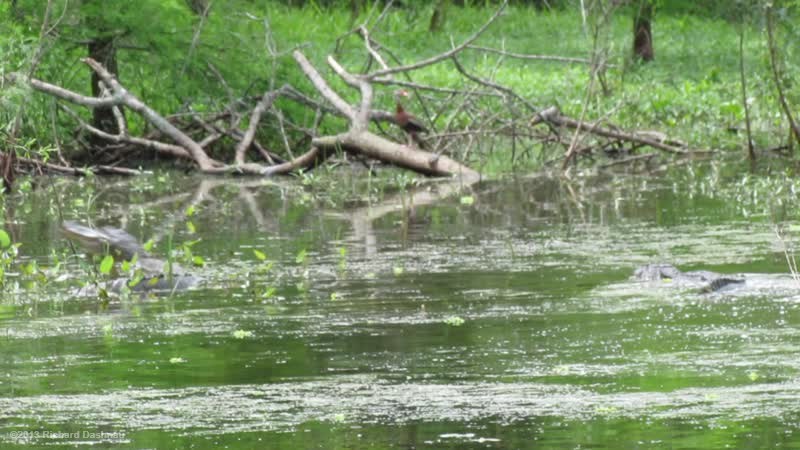
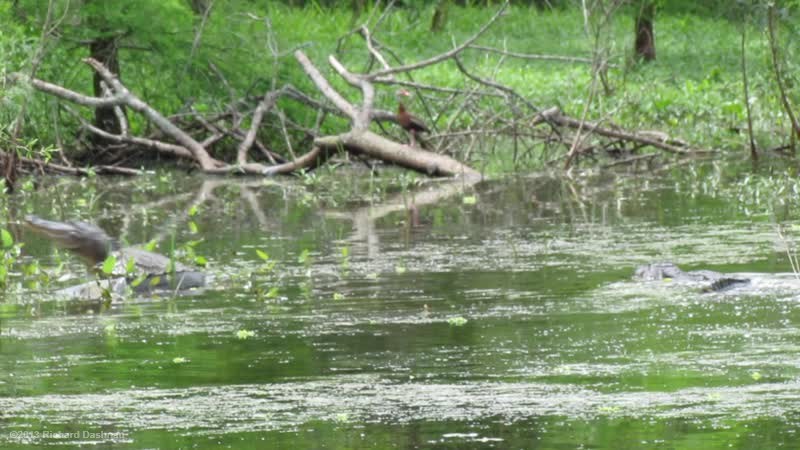
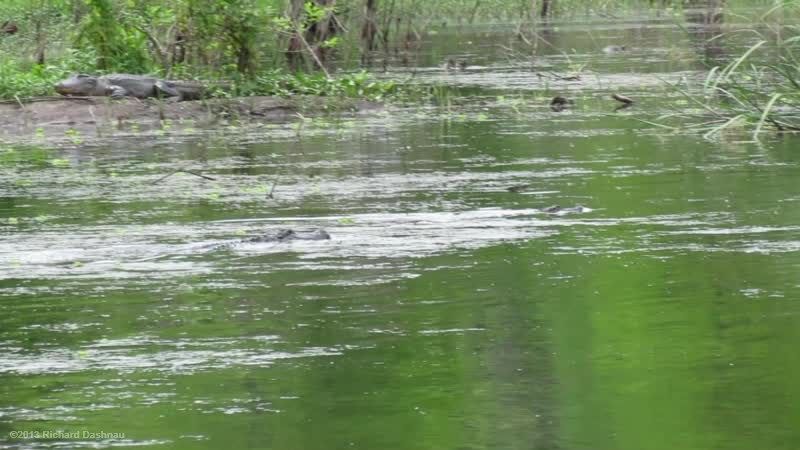
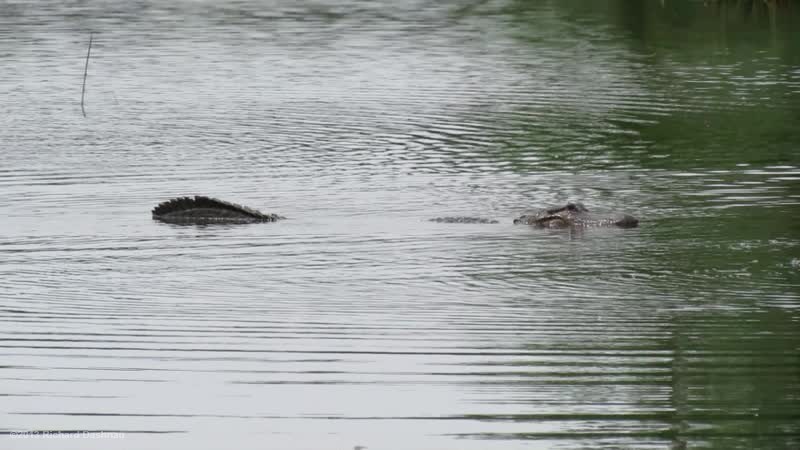
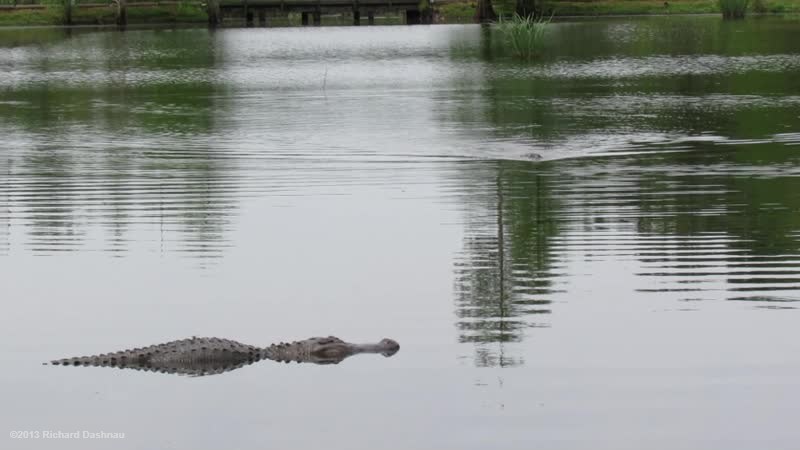
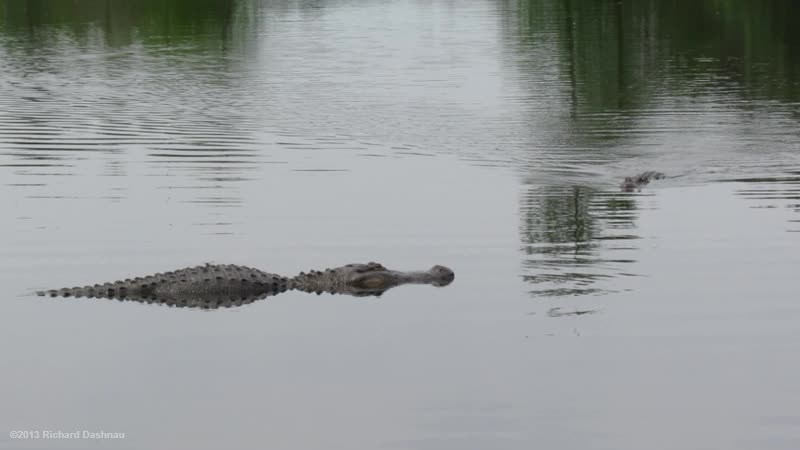
The
pursuing alligator then moved towards the BIG alligator, which had
been
lying quietly during all of the other activity--which had been at
least
50 yards away.
The alligator slowed down, and then eventually moved
closer to the big gator. It moved until its snout was almost
touching
the big alligator's ear. Then it did some
"champing"--clamping its jaws
together under the water.
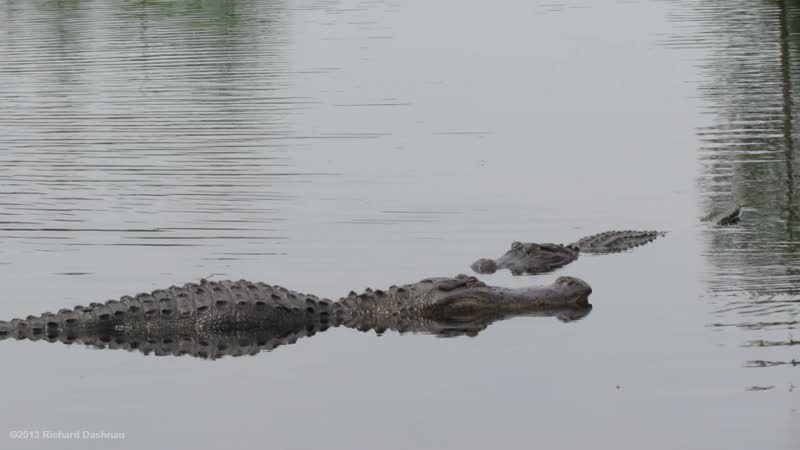
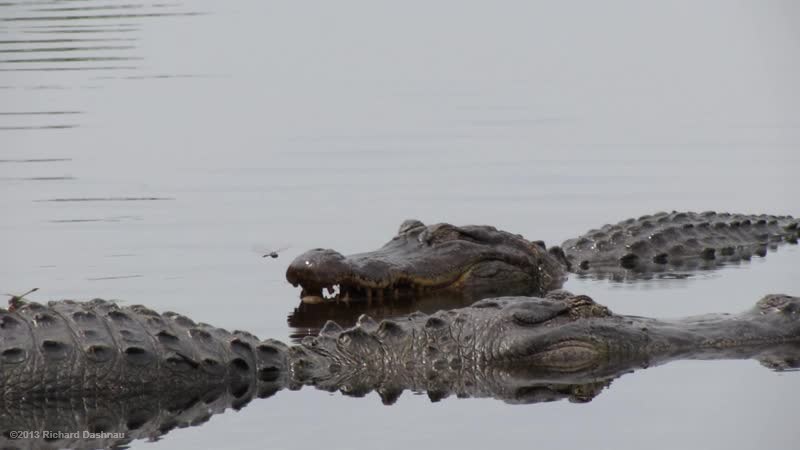
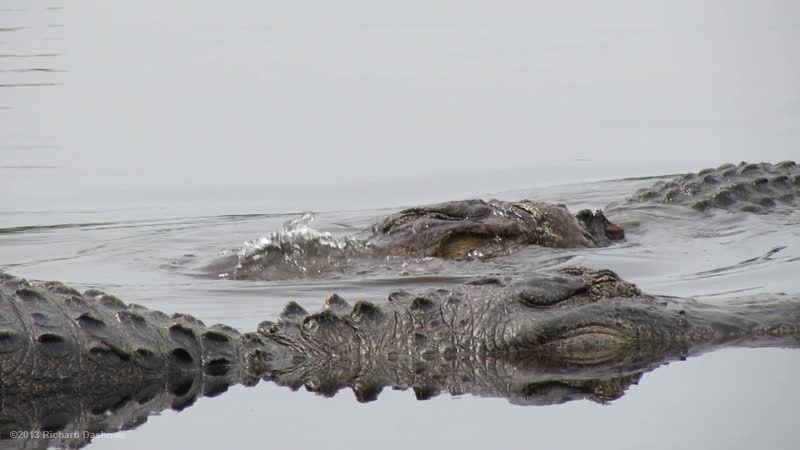
Then it raised its
head and bellowed, right
near the big alligator's head. After a few bellows, the big
alligator
started bellowing, and then there was a good bout of
bellowing. During
the bout with the two close alligators the alligator out past the
bird
box started bellowing, too. After a couple bouts of
bellowing,
they stopped,
and the "instigator" alligator swam back to the far
bank.
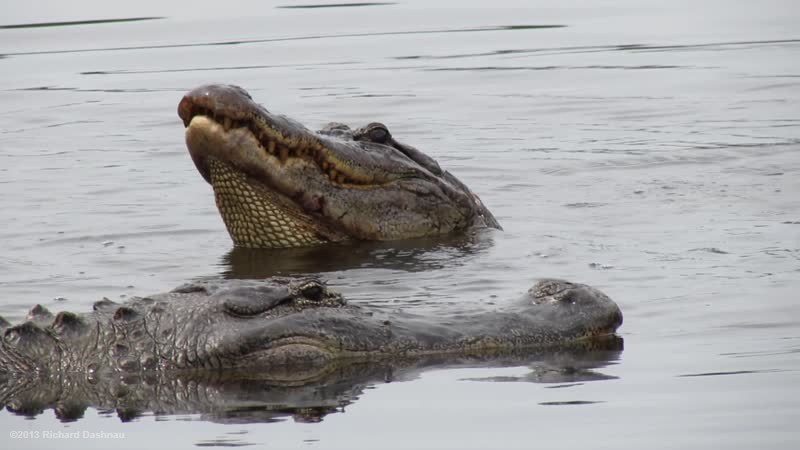
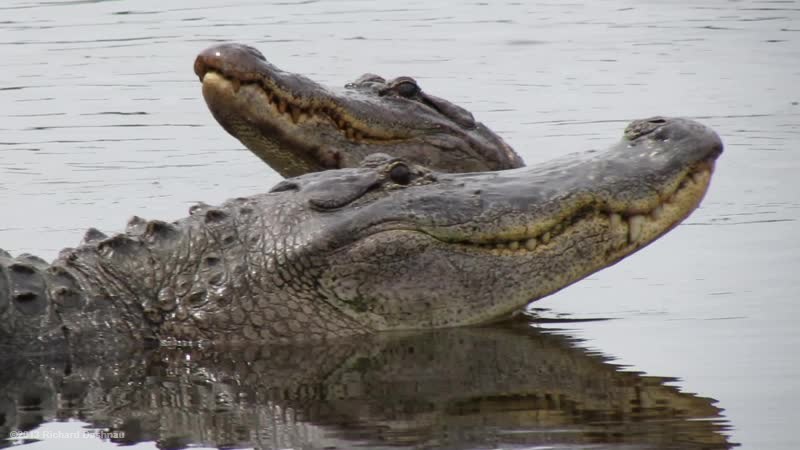
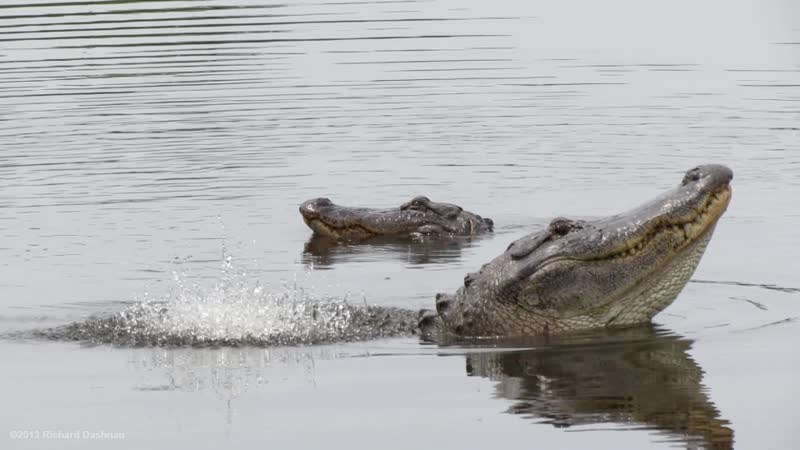
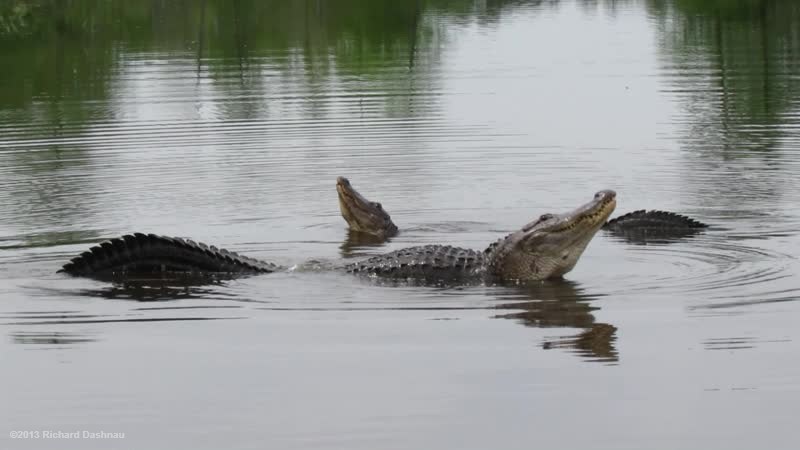
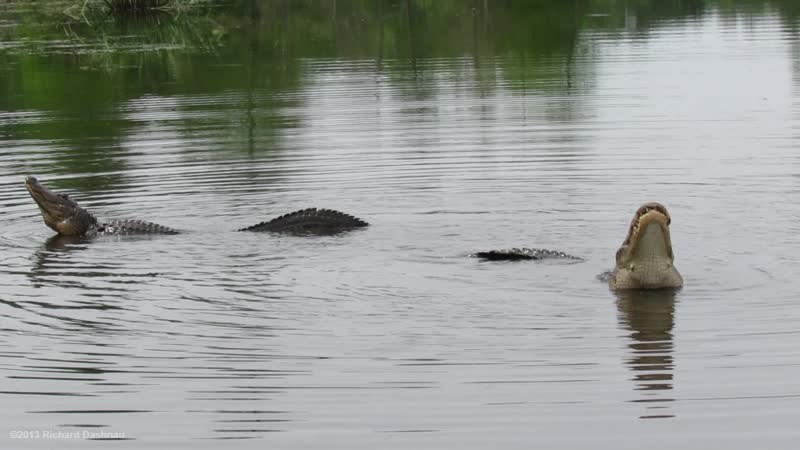
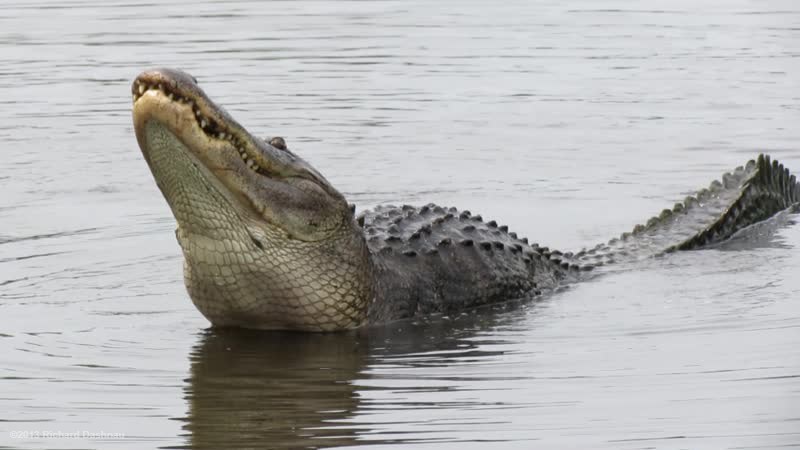
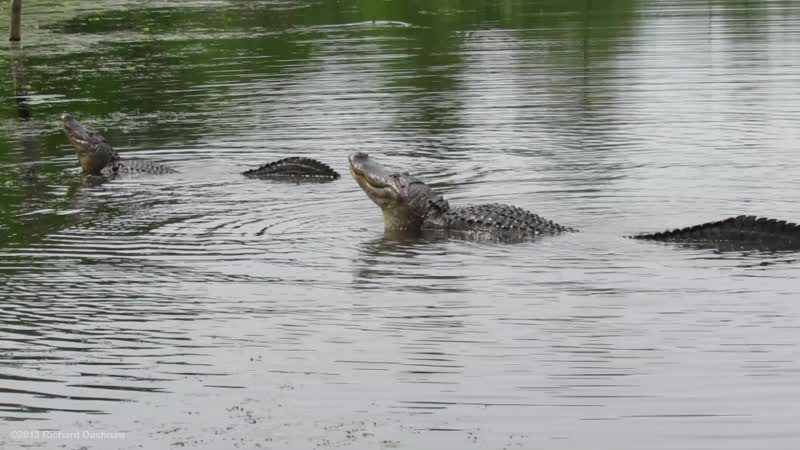
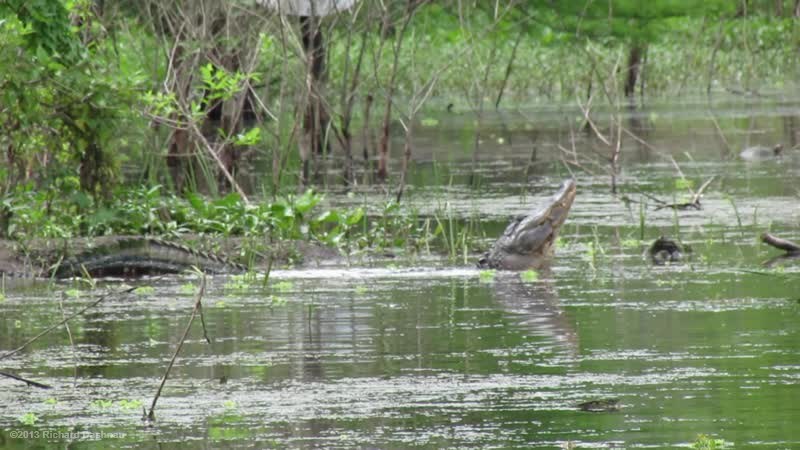
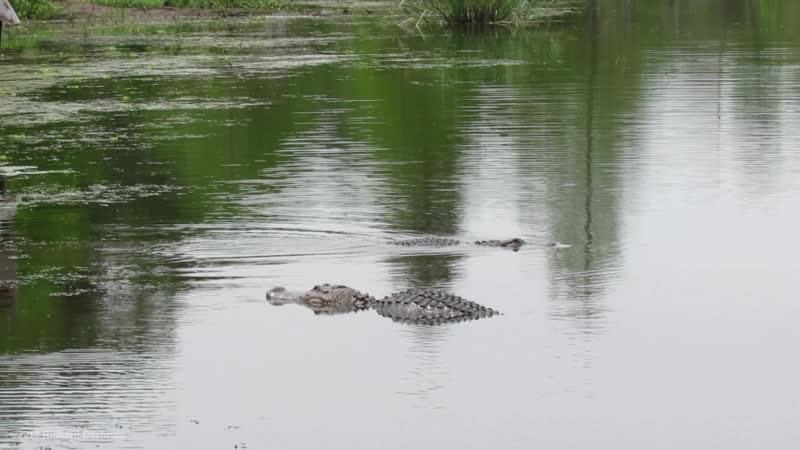

I
was very excited to capture this footage. The conditions were almost
perfect. The wind was relatively still, and although people were
talking, they were in the
background. Note the difference in volume
when the alligators are turned towards me! There are a few good
online
sources that describe alligator social signals.
Between them
both, most of the actions shown here are described. One of the
earliest
detailed studies is still available online:
Social
Signals of Adult American
Alligators, by Leslie Garrick, Jeffrey Lang, and
Harold Herzog
(Bulletin of the American Museum of Natural History NY, 1978).
And, there are: Courtship
Behavior
of American Alligators, by Kent A. Vliet, Ph. D.--in
pages
383-408 of Crocodilian Biology and Evolution edited
by Gordon C.
Grigg, Frank Seebacher, and Craig E. Franklin; Pub. Feb 2001. ;
Social
Displays of the American Alligator by Kent A. Vliet in
Amer.
Zool.,
29:1019-1031 (1989).
Search for those titles--a couple of them are out there.
When
I
link to them...they move, so I don't link to outside files any
more.
The edited video of these events is here(mp4).
I have many other examples of alligator social interaction
(agonistic
displays) on my alligator "social signals" pages.;
starting with this
one.
And,
this
page shows alligators at the park, on land, near various
landmarks at the park.
Go back to my main alligator page, Alligators
Go
back to my home page, Welcome
to rickubis.com
Go
back to the See
the World
page.














































































